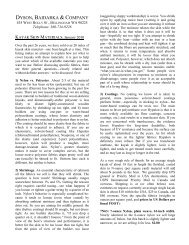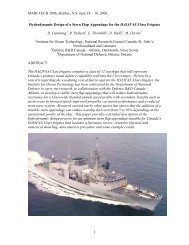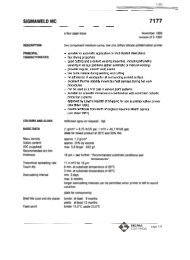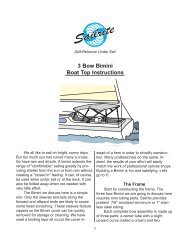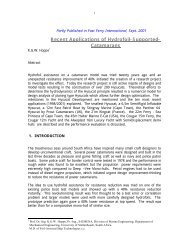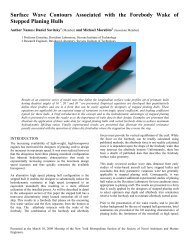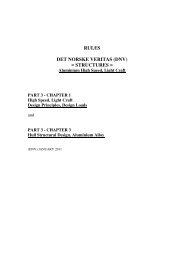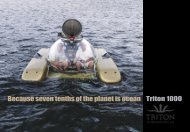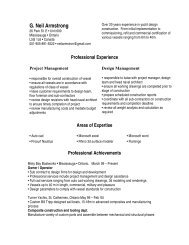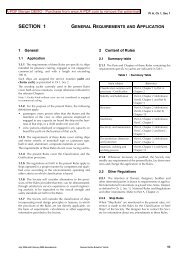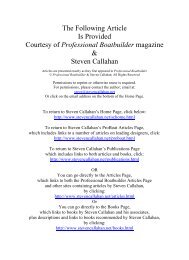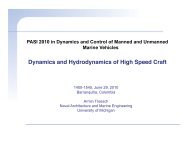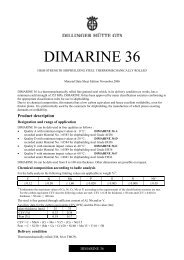Rules for the Classification of Floating Docks - Boat Design Net
Rules for the Classification of Floating Docks - Boat Design Net
Rules for the Classification of Floating Docks - Boat Design Net
Create successful ePaper yourself
Turn your PDF publications into a flip-book with our unique Google optimized e-Paper software.
<strong>Rules</strong> <strong>for</strong> <strong>the</strong> <strong>Classification</strong><strong>of</strong> <strong>Floating</strong> <strong>Docks</strong>Effective from 1 January 2010RINAVia Corsica, 12 - 16128 Genova - ItalyTel. +39 01053851 - Fax: +39 0105351000E-MAIL info@rina.org - WEB www.rina.org
© RINA S.p.A. - All rights reserved
Definitions:"<strong>Rules</strong>" in <strong>the</strong>se General Conditions means <strong>the</strong> documents belowissued by <strong>the</strong> Society:- <strong>Rules</strong> <strong>for</strong> <strong>the</strong> <strong>Classification</strong> <strong>of</strong> Ships or o<strong>the</strong>r special units;- Complementary <strong>Rules</strong> containing <strong>the</strong> requirements <strong>for</strong> product,plant, system and o<strong>the</strong>r certification or containing <strong>the</strong> requirements<strong>for</strong> <strong>the</strong> assignment <strong>of</strong> additional class notations;- <strong>Rules</strong> <strong>for</strong> <strong>the</strong> application <strong>of</strong> statutory rules, containing <strong>the</strong> rules toper<strong>for</strong>m <strong>the</strong> duties delegated by Administrations;- Guides to carry out particular activities connected with Services;- Any o<strong>the</strong>r technical document, as <strong>for</strong> example rule variations orinterpretations.“Services” means <strong>the</strong> activities described in Article 1 below, renderedby <strong>the</strong> Society upon request made by or on behalf <strong>of</strong> <strong>the</strong>Interested Party.“Society” or “RINA” means RINA S.p.A. and/or all <strong>the</strong> companiesin <strong>the</strong> RINA Group which provide <strong>the</strong> Services.“Surveyor” means technical staff acting on behalf <strong>of</strong> <strong>the</strong> Society inper<strong>for</strong>ming <strong>the</strong> Services.“Interested Party” means <strong>the</strong> party, o<strong>the</strong>r than <strong>the</strong> Society, havingan interest in or responsibility <strong>for</strong> <strong>the</strong> Ship, product, plant or systemsubject to classification or certification (such as <strong>the</strong> owner <strong>of</strong><strong>the</strong> Ship and his representatives, <strong>the</strong> ship builder, <strong>the</strong> enginebuilder or <strong>the</strong> supplier <strong>of</strong> parts to be tested) who requests <strong>the</strong> Servicesor on whose behalf <strong>the</strong> Services are requested.“Owner” means <strong>the</strong> registered Owner, <strong>the</strong> ship Owner, <strong>the</strong> manageror any o<strong>the</strong>r party with <strong>the</strong> responsibility, legally or contractually,to keep <strong>the</strong> ship seaworthy or in service, having particularregard to <strong>the</strong> provisions relating to <strong>the</strong> maintenance <strong>of</strong> class laiddown in Part A, Chapter 2 <strong>of</strong> <strong>the</strong> <strong>Rules</strong> <strong>for</strong> <strong>the</strong> <strong>Classification</strong> <strong>of</strong>Ships or in <strong>the</strong> corresponding rules indicated in <strong>the</strong> specific <strong>Rules</strong>.“Administration” means <strong>the</strong> Government <strong>of</strong> <strong>the</strong> State whose flag<strong>the</strong> Ship is entitled to fly or under whose authority <strong>the</strong> Ship isauthorised to operate in <strong>the</strong> specific case."Ship" means ships, boats, craft and o<strong>the</strong>r special units, as <strong>for</strong>example <strong>of</strong>fshore structures, floating units and underwater craft.Article 11.1. - The purpose <strong>of</strong> <strong>the</strong> Society is, among o<strong>the</strong>rs, <strong>the</strong> classificationand certification <strong>of</strong> ships and <strong>the</strong> certification <strong>of</strong> <strong>the</strong>ir partsand components.The Society:- sets <strong>for</strong>th and develops <strong>Rules</strong>;- publishes <strong>the</strong> Register <strong>of</strong> Ships;- issues certificates, statements and reports based on its surveyactivities.1.2. - The Society also takes part in <strong>the</strong> implementation <strong>of</strong> nationaland international rules and standards as delegated by various Governments.1.3. – The Society carries out technical assistance activities onrequest and provides special services outside <strong>the</strong> scope <strong>of</strong> classification,which are regulated by <strong>the</strong>se general conditions, unlessexpressly excluded in <strong>the</strong> particular contract.Article 22.1. - The <strong>Rules</strong> developed by <strong>the</strong> Society reflect <strong>the</strong> level <strong>of</strong> itstechnical knowledge at <strong>the</strong> time <strong>the</strong>y are published. There<strong>for</strong>e, <strong>the</strong>Society, though committed, also through its research and developmentservices, to continuous updating, does not guarantee <strong>the</strong>ymeet state-<strong>of</strong>-<strong>the</strong>-art science and technology at <strong>the</strong> time <strong>of</strong> publicationor that <strong>the</strong>y meet <strong>the</strong> Society's or o<strong>the</strong>rs' subsequent technicaldevelopments.2.2. - The Interested Party is required to know <strong>the</strong> <strong>Rules</strong> on <strong>the</strong>basis <strong>of</strong> which <strong>the</strong> Services are provided. With particular referenceto <strong>Classification</strong> Services, special attention is to be given to <strong>the</strong><strong>Rules</strong> concerning class suspension, withdrawal and reinstatement.In case <strong>of</strong> doubt or inaccuracy, <strong>the</strong> Interested Party is to promptlycontact <strong>the</strong> Society <strong>for</strong> clarification.The <strong>Rules</strong> <strong>for</strong> <strong>Classification</strong> <strong>of</strong> Ships are published on <strong>the</strong> Society'swebsite: www.rina.org.2.3. - The Society exercises due care and skill:- in <strong>the</strong> selection <strong>of</strong> its Surveyors- in <strong>the</strong> per<strong>for</strong>mance <strong>of</strong> its Services, taking into account <strong>the</strong> level <strong>of</strong>its technical knowledge at <strong>the</strong> time <strong>the</strong> Services are per<strong>for</strong>med.2.4. - Surveys conducted by <strong>the</strong> Society include, but are not limitedto, visual inspection and non-destructive testing. Unless o<strong>the</strong>rwiserequired, surveys are conducted through samplingtechniques and do not consist <strong>of</strong> comprehensive verification ormonitoring <strong>of</strong> <strong>the</strong> Ship or <strong>of</strong> <strong>the</strong> items subject to certification. Thesurveys and checks made by <strong>the</strong> Society on board ship do not necessarilyrequire <strong>the</strong> constant and continuous presence <strong>of</strong> <strong>the</strong> Surveyor.The Society may also commission laboratory testing,underwater inspection and o<strong>the</strong>r checks carried out by and underGENERAL CONDITIONS<strong>the</strong> responsibility <strong>of</strong> qualified service suppliers. Survey practicesand procedures are selected by <strong>the</strong> Society based on its experienceand knowledge and according to generally accepted technicalstandards in <strong>the</strong> sector.Article 33.1. - The class assigned to a Ship, like <strong>the</strong> reports, statements, certificatesor any o<strong>the</strong>r document or in<strong>for</strong>mation issued by <strong>the</strong> Society,reflects <strong>the</strong> opinion <strong>of</strong> <strong>the</strong> Society concerning compliance, at<strong>the</strong> time <strong>the</strong> Service is provided, <strong>of</strong> <strong>the</strong> Ship or product subject tocertification, with <strong>the</strong> applicable <strong>Rules</strong> (given <strong>the</strong> intended use andwithin <strong>the</strong> relevant time frame).The Society is under no obligation to make statements or providein<strong>for</strong>mation about elements or facts which are not part <strong>of</strong> <strong>the</strong> specificscope <strong>of</strong> <strong>the</strong> Service requested by <strong>the</strong> Interested Party or on itsbehalf.3.2. - No report, statement, notation on a plan, review, Certificate<strong>of</strong> <strong>Classification</strong>, document or in<strong>for</strong>mation issued or given as part<strong>of</strong> <strong>the</strong> Services provided by <strong>the</strong> Society shall have any legal effector implication o<strong>the</strong>r than a representation that, on <strong>the</strong> basis <strong>of</strong> <strong>the</strong>checks made by <strong>the</strong> Society, <strong>the</strong> Ship, structure, materials, equipment,machinery or any o<strong>the</strong>r item covered by such document orin<strong>for</strong>mation meet <strong>the</strong> <strong>Rules</strong>. Any such document is issued solely<strong>for</strong> <strong>the</strong> use <strong>of</strong> <strong>the</strong> Society, its committees and clients or o<strong>the</strong>r dulyauthorised bodies and <strong>for</strong> no o<strong>the</strong>r purpose. There<strong>for</strong>e, <strong>the</strong> Societycannot be held liable <strong>for</strong> any act made or document issued byo<strong>the</strong>r parties on <strong>the</strong> basis <strong>of</strong> <strong>the</strong> statements or in<strong>for</strong>mation given by<strong>the</strong> Society. The validity, application, meaning and interpretation<strong>of</strong> a Certificate <strong>of</strong> <strong>Classification</strong>, or any o<strong>the</strong>r document or in<strong>for</strong>mationissued by <strong>the</strong> Society in connection with its Services, isgoverned by <strong>the</strong> <strong>Rules</strong> <strong>of</strong> <strong>the</strong> Society, which is <strong>the</strong> sole subjectentitled to make such interpretation. Any disagreement on technicalmatters between <strong>the</strong> Interested Party and <strong>the</strong> Surveyor in <strong>the</strong>carrying out <strong>of</strong> his functions shall be raised in writing as soon aspossible with <strong>the</strong> Society, which will settle any divergence <strong>of</strong> opinionor dispute.3.3. - The classification <strong>of</strong> a Ship, or <strong>the</strong> issuance <strong>of</strong> a certificate oro<strong>the</strong>r document connected with classification or certification andin general with <strong>the</strong> per<strong>for</strong>mance <strong>of</strong> Services by <strong>the</strong> Society shallhave <strong>the</strong> validity conferred upon it by <strong>the</strong> <strong>Rules</strong> <strong>of</strong> <strong>the</strong> Society at<strong>the</strong> time <strong>of</strong> <strong>the</strong> assignment <strong>of</strong> class or issuance <strong>of</strong> <strong>the</strong> certificate; inno case shall it amount to a statement or warranty <strong>of</strong> seaworthiness,structural integrity, quality or fitness <strong>for</strong> a particular purposeor service <strong>of</strong> any Ship, structure, material, equipment or machineryinspected or tested by <strong>the</strong> Society.3.4. - Any document issued by <strong>the</strong> Society in relation to its activitiesreflects <strong>the</strong> condition <strong>of</strong> <strong>the</strong> Ship or <strong>the</strong> subject <strong>of</strong> certificationor o<strong>the</strong>r activity at <strong>the</strong> time <strong>of</strong> <strong>the</strong> check.3.5. - The <strong>Rules</strong>, surveys and activities per<strong>for</strong>med by <strong>the</strong> Society,reports, certificates and o<strong>the</strong>r documents issued by <strong>the</strong> Society arein no way intended to replace <strong>the</strong> duties and responsibilities <strong>of</strong>o<strong>the</strong>r parties such as Governments, designers, ship builders, manufacturers,repairers, suppliers, contractors or sub-contractors,Owners, operators, charterers, underwriters, sellers or intendedbuyers <strong>of</strong> a Ship or o<strong>the</strong>r product or system surveyed.These documents and activities do not relieve such parties fromany fulfilment, warranty, responsibility, duty or obligation (also <strong>of</strong> acontractual nature) expressed or implied or in any case incumbenton <strong>the</strong>m, nor do <strong>the</strong>y confer on such parties any right, claim orcause <strong>of</strong> action against <strong>the</strong> Society. With particular regard to <strong>the</strong>duties <strong>of</strong> <strong>the</strong> ship Owner, <strong>the</strong> Services undertaken by <strong>the</strong> Societydo not relieve <strong>the</strong> Owner <strong>of</strong> his duty to ensure proper maintenance<strong>of</strong> <strong>the</strong> Ship and ensure seaworthiness at all times. Likewise, <strong>the</strong><strong>Rules</strong>, surveys per<strong>for</strong>med, reports, certificates and o<strong>the</strong>r documentsissued by <strong>the</strong> Society are intended nei<strong>the</strong>r to guarantee <strong>the</strong>buyers <strong>of</strong> <strong>the</strong> Ship, its components or any o<strong>the</strong>r surveyed or certifieditem, nor to relieve <strong>the</strong> seller <strong>of</strong> <strong>the</strong> duties arising out <strong>of</strong> <strong>the</strong>law or <strong>the</strong> contract, regarding <strong>the</strong> quality, commercial value orcharacteristics <strong>of</strong> <strong>the</strong> item which is <strong>the</strong> subject <strong>of</strong> transaction.In no case, <strong>the</strong>re<strong>for</strong>e, shall <strong>the</strong> Society assume <strong>the</strong> obligationsincumbent upon <strong>the</strong> above-mentioned parties, even when it isconsulted in connection with matters not covered by its <strong>Rules</strong> oro<strong>the</strong>r documents.In consideration <strong>of</strong> <strong>the</strong> above, <strong>the</strong> Interested Party undertakes torelieve and hold harmless <strong>the</strong> Society from any third party claim,as well as from any liability in relation to <strong>the</strong> latter concerning <strong>the</strong>Services rendered.Ins<strong>of</strong>ar as <strong>the</strong>y are not expressly provided <strong>for</strong> in <strong>the</strong>se GeneralConditions, <strong>the</strong> duties and responsibilities <strong>of</strong> <strong>the</strong> Owner and InterestedParties with respect to <strong>the</strong> services rendered by <strong>the</strong> Societyare described in <strong>the</strong> <strong>Rules</strong> applicable to <strong>the</strong> specific Service rendered.
Article 44.1. – Any request <strong>for</strong> <strong>the</strong> Society's Services shall be submitted inwriting and signed by or on behalf <strong>of</strong> <strong>the</strong> Interested Party. Such arequest will be considered irrevocable as soon as received by <strong>the</strong>Society and shall entail acceptance by <strong>the</strong> applicant <strong>of</strong> all relevantrequirements <strong>of</strong> <strong>the</strong> <strong>Rules</strong>, including <strong>the</strong>se General Conditions.Upon acceptance <strong>of</strong> <strong>the</strong> written request by <strong>the</strong> Society, a contractbetween <strong>the</strong> Society and <strong>the</strong> Interested Party is entered into, whichis regulated by <strong>the</strong> present General Conditions.4.2. – In consideration <strong>of</strong> <strong>the</strong> Services rendered by <strong>the</strong> Society, <strong>the</strong>Interested Party and <strong>the</strong> person requesting <strong>the</strong> service shall bejointly liable <strong>for</strong> <strong>the</strong> payment <strong>of</strong> <strong>the</strong> relevant fees, even if <strong>the</strong> serviceis not concluded <strong>for</strong> any cause not pertaining to <strong>the</strong> Society.In <strong>the</strong> latter case, <strong>the</strong> Society shall not be held liable <strong>for</strong> non-fulfilmentor partial fulfilment <strong>of</strong> <strong>the</strong> Services requested. In <strong>the</strong> event <strong>of</strong>late payment, interest at <strong>the</strong> legal current rate increased by 2%may be demanded.4.3. - The contract <strong>for</strong> <strong>the</strong> classification <strong>of</strong> a Ship or <strong>for</strong> o<strong>the</strong>r Servicesmay be terminated and any certificates revoked at <strong>the</strong>request <strong>of</strong> one <strong>of</strong> <strong>the</strong> parties, subject to at least 30 days' notice tobe given in writing. Failure to pay, even in part, <strong>the</strong> fees due <strong>for</strong>Services carried out by <strong>the</strong> Society will entitle <strong>the</strong> Society to immediatelyterminate <strong>the</strong> contract and suspend <strong>the</strong> Services.For every termination <strong>of</strong> <strong>the</strong> contract, <strong>the</strong> fees <strong>for</strong> <strong>the</strong> activities per<strong>for</strong>meduntil <strong>the</strong> time <strong>of</strong> <strong>the</strong> termination shall be owed to <strong>the</strong> Societyas well as <strong>the</strong> expenses incurred in view <strong>of</strong> activities alreadyprogrammed; this is without prejudice to <strong>the</strong> right to compensationdue to <strong>the</strong> Society as a consequence <strong>of</strong> <strong>the</strong> termination.With particular reference to Ship classification and certification,unless decided o<strong>the</strong>rwise by <strong>the</strong> Society, termination <strong>of</strong> <strong>the</strong> contractimplies that <strong>the</strong> assignment <strong>of</strong> class to a Ship is withheld or, ifalready assigned, that it is suspended or withdrawn; any statutorycertificates issued by <strong>the</strong> Society will be withdrawn in those caseswhere provided <strong>for</strong> by agreements between <strong>the</strong> Society and <strong>the</strong>flag State.Article 55.1. - In providing <strong>the</strong> Services, as well as o<strong>the</strong>r correlated in<strong>for</strong>mationor advice, <strong>the</strong> Society, its Surveyors, servants or agentsoperate with due diligence <strong>for</strong> <strong>the</strong> proper execution <strong>of</strong> <strong>the</strong> activity.However, considering <strong>the</strong> nature <strong>of</strong> <strong>the</strong> activities per<strong>for</strong>med (seeart. 2.4), it is not possible to guarantee absolute accuracy, correctnessand completeness <strong>of</strong> any in<strong>for</strong>mation or advice supplied.Express and implied warranties are specifically disclaimed.There<strong>for</strong>e, except as provided <strong>for</strong> in paragraph 5.2 below, and alsoin <strong>the</strong> case <strong>of</strong> activities carried out by delegation <strong>of</strong> Governments,nei<strong>the</strong>r <strong>the</strong> Society nor any <strong>of</strong> its Surveyors will be liable <strong>for</strong> anyloss, damage or expense <strong>of</strong> whatever nature sustained by any person,in tort or in contract, derived from carrying out <strong>the</strong> Services.5.2. – Notwithstanding <strong>the</strong> provisions in paragraph 5.1 above,should any user <strong>of</strong> <strong>the</strong> Society's Services prove that he has suffereda loss or damage due to any negligent act or omission <strong>of</strong> <strong>the</strong> Society,its Surveyors, servants or agents, <strong>the</strong>n <strong>the</strong> Society will paycompensation to such person <strong>for</strong> his proved loss, up to, but notexceeding, five times <strong>the</strong> amount <strong>of</strong> <strong>the</strong> fees charged <strong>for</strong> <strong>the</strong> specificservices, in<strong>for</strong>mation or opinions from which <strong>the</strong> loss or damagederives or, if no fee has been charged, a maximum <strong>of</strong> onehundred thousand Euro. Where <strong>the</strong> fees charged are related to anumber <strong>of</strong> Services, <strong>the</strong> amount <strong>of</strong> <strong>the</strong> fees will be apportioned <strong>for</strong><strong>the</strong> purpose <strong>of</strong> <strong>the</strong> calculation <strong>of</strong> <strong>the</strong> maximum compensation, byreference to <strong>the</strong> estimated time involved in <strong>the</strong> per<strong>for</strong>mance <strong>of</strong> <strong>the</strong>Service from which <strong>the</strong> damage or loss derives. Any liability <strong>for</strong>indirect or consequential loss, damage or expense is specificallyexcluded. In any case, irrespective <strong>of</strong> <strong>the</strong> amount <strong>of</strong> <strong>the</strong> feescharged, <strong>the</strong> maximum damages payable by <strong>the</strong> Society will notbe more than 1 million Euro. Payment <strong>of</strong> compensation under thisparagraph will not entail any admission <strong>of</strong> responsibility and/orliability by <strong>the</strong> Society and will be made without prejudice to <strong>the</strong>disclaimer clause contained in paragraph 5.1 above.5.3. - Any claim <strong>for</strong> loss or damage <strong>of</strong> whatever nature by virtue <strong>of</strong><strong>the</strong> provisions set <strong>for</strong>th herein shall be made to <strong>the</strong> Society in writing,within <strong>the</strong> shorter <strong>of</strong> <strong>the</strong> following periods: THREE MONTHSfrom <strong>the</strong> date on which <strong>the</strong> Services were per<strong>for</strong>med or THREEMONTHS from <strong>the</strong> date on which <strong>the</strong> damage was discovered.Failure to comply with <strong>the</strong> above deadline will constitute an absolutebar to <strong>the</strong> pursuit <strong>of</strong> such a claim against <strong>the</strong> Society.Article 66.1. - Any dispute arising from or in connection with <strong>the</strong> <strong>Rules</strong> orwith <strong>the</strong> Services <strong>of</strong> <strong>the</strong> Society, including any issues concerningresponsibility, liability or limitations <strong>of</strong> liability <strong>of</strong> <strong>the</strong> Society, willbe determined in accordance with Italian Law and settled througharbitration assigned to a board <strong>of</strong> three arbitrators who will proceedin compliance with <strong>the</strong> <strong>Rules</strong> <strong>of</strong> <strong>the</strong> Chamber <strong>of</strong> Nationaland International Arbitration <strong>of</strong> Milan. Arbitration will take placein Genoa, Italy.6.2. - However, <strong>for</strong> disputes concerning non-payment <strong>of</strong> <strong>the</strong> feesand/or expenses due to <strong>the</strong> Society <strong>for</strong> services, <strong>the</strong> Society shallhave <strong>the</strong> right to submit any claim to <strong>the</strong> jurisdiction <strong>of</strong> <strong>the</strong> Courts<strong>of</strong> <strong>the</strong> place where <strong>the</strong> registered or operating <strong>of</strong>fice <strong>of</strong> <strong>the</strong> InterestedParty or <strong>of</strong> <strong>the</strong> applicant who requested <strong>the</strong> Service islocated.In <strong>the</strong> case <strong>of</strong> actions taken against <strong>the</strong> Society by a third partybe<strong>for</strong>e a public Court, <strong>the</strong> Society shall also have <strong>the</strong> right to summon<strong>the</strong> Interested Party or <strong>the</strong> subject who requested <strong>the</strong> Servicebe<strong>for</strong>e that Court, in order to be relieved and held harmlessaccording to art. 3.5 above.Article 77.1. - All plans, specifications, documents and in<strong>for</strong>mation providedby, issued by, or made known to <strong>the</strong> Society, in connectionwith <strong>the</strong> per<strong>for</strong>mance <strong>of</strong> its Services, will be treated as confidentialand will not be made available to any o<strong>the</strong>r party o<strong>the</strong>r than <strong>the</strong>Owner without authorisation <strong>of</strong> <strong>the</strong> Interested Party, except as provided<strong>for</strong> or required by any applicable international, European ordomestic legislation, Charter or o<strong>the</strong>r IACS resolutions, or orderfrom a competent authority. In<strong>for</strong>mation about <strong>the</strong> status andvalidity <strong>of</strong> class and statutory certificates, including transfers,changes, suspensions, withdrawals <strong>of</strong> class, recommendations/conditions <strong>of</strong> class, operating conditions or restrictions issuedagainst classed ships and o<strong>the</strong>r related in<strong>for</strong>mation, as may berequired, may be published on <strong>the</strong> website or released by o<strong>the</strong>rmeans, without <strong>the</strong> prior consent <strong>of</strong> <strong>the</strong> Interested Party.In<strong>for</strong>mation about <strong>the</strong> status and validity <strong>of</strong> o<strong>the</strong>r certificates andstatements may also be published on <strong>the</strong> website or released byo<strong>the</strong>r means, without <strong>the</strong> prior consent <strong>of</strong> <strong>the</strong> Interested Party.7.2. - Notwithstanding <strong>the</strong> general duty <strong>of</strong> confidentiality owed by<strong>the</strong> Society to its clients in clause 7.1 above, <strong>the</strong> Society's clientshereby accept that <strong>the</strong> Society will participate in <strong>the</strong> IACS EarlyWarning System which requires <strong>Classification</strong> Society to provideo<strong>the</strong>r involved <strong>Classification</strong> Societies with relevant technicalin<strong>for</strong>mation on serious hull structural and engineering systems failures,as defined in <strong>the</strong> IACS Early Warning System (but not includingany drawings relating to <strong>the</strong> ship which may be <strong>the</strong> specificproperty <strong>of</strong> ano<strong>the</strong>r party), to enable such useful in<strong>for</strong>mation to beshared and used to facilitate <strong>the</strong> proper working <strong>of</strong> <strong>the</strong> IACS EarlyWarning System. The Society will provide its clients with writtendetails <strong>of</strong> such in<strong>for</strong>mation sent to <strong>the</strong> involved <strong>Classification</strong>Societies.7.3. - In <strong>the</strong> event <strong>of</strong> transfer <strong>of</strong> class, addition <strong>of</strong> a second class orwithdrawal from a double/dual class, <strong>the</strong> Interested Party undertakesto provide or to permit <strong>the</strong> Society to provide <strong>the</strong> o<strong>the</strong>r <strong>Classification</strong>Society with all building plans and drawings, certificates,documents and in<strong>for</strong>mation relevant to <strong>the</strong> classed unit, includingits history file, as <strong>the</strong> o<strong>the</strong>r <strong>Classification</strong> Society may require <strong>for</strong><strong>the</strong> purpose <strong>of</strong> classification in compliance with <strong>the</strong> applicablelegislation and relative IACS Procedure. It is <strong>the</strong> Owner's duty toensure that, whenever required, <strong>the</strong> consent <strong>of</strong> <strong>the</strong> builder isobtained with regard to <strong>the</strong> provision <strong>of</strong> plans and drawings to <strong>the</strong>new Society, ei<strong>the</strong>r by way <strong>of</strong> appropriate stipulation in <strong>the</strong> buildingcontract or by o<strong>the</strong>r agreement.In <strong>the</strong> event that <strong>the</strong> ownership <strong>of</strong> <strong>the</strong> ship, product or system subjectto certification is transferred to a new subject, <strong>the</strong> latter shallhave <strong>the</strong> right to access all pertinent drawings, specifications, documentsor in<strong>for</strong>mation issued by <strong>the</strong> Society or which has come to<strong>the</strong> knowledge <strong>of</strong> <strong>the</strong> Society while carrying out its Services, evenif related to a period prior to transfer <strong>of</strong> ownership.Pursuant and owing to Italian legislative decree 196/2003, <strong>the</strong>Interested Party declares that it has read <strong>the</strong> in<strong>for</strong>mation sheet concerning<strong>the</strong> processing <strong>of</strong> personal data published on <strong>the</strong> society'swebsite and gives its consent to such processing, also <strong>for</strong> commercialin<strong>for</strong>mation purposes.Article 88.1. – Should any part <strong>of</strong> <strong>the</strong>se General Conditions be declaredinvalid, this will not affect <strong>the</strong> validity <strong>of</strong> <strong>the</strong> remaining provisions.8.2. - In <strong>the</strong> event <strong>of</strong> doubts concerning <strong>the</strong> interpretation <strong>of</strong> <strong>the</strong>seGeneral Conditions, <strong>the</strong> Italian text will prevail.Article 99.1. – When <strong>the</strong> Society provides its Services to a consumer - i.e. anatural person who does not act within <strong>the</strong> scope <strong>of</strong> his businessor pr<strong>of</strong>essional activity - <strong>the</strong> following provisions do not apply: art.3.2. (as far as <strong>the</strong> Society is solely entitled to <strong>the</strong> interpretation <strong>of</strong><strong>the</strong> <strong>Rules</strong>); art. 4.2., (as far as <strong>the</strong> payment <strong>of</strong> <strong>the</strong> fees is also due<strong>for</strong> services not concluded due to causes not attributable to <strong>the</strong>Interested Party); art. 5.1. (as far as <strong>the</strong> exclusion <strong>of</strong> liability is concerned);art. 5.2.; art. 5.3.; and art. 6.1. (as far as <strong>the</strong> jurisdiction<strong>of</strong> a Board <strong>of</strong> Arbitrators based in Genoa is concerned).
RULES FOR THE CLASSIFICATION OFFLOATING DOCKSChapters 1 2 3 4 5 6Chapter 1Chapter 2Chapter 3Chapter 4Chapter 5Chapter 6Application and General<strong>Classification</strong>Survey RequirementsHull, Stability and MaterialsMachinery and SystemsFire Protection
CHAPTER 1 APPLICATION AND GENERAL1 Application 91.1 General2 General 92.1 Statutory regulations2.2 Abbreviations<strong>Rules</strong> <strong>for</strong> floating docks 2010 3
CHAPTER 2 CLASSIFICATION1 Premise 101.1 Reference to <strong>the</strong> <strong>Rules</strong>2 Class notations 102.1 Service notation2.2 Navigation notations2.3 Annotations in <strong>the</strong> Certificate <strong>of</strong> <strong>Classification</strong>4 <strong>Rules</strong> <strong>for</strong> floating docks 2010
CHAPTER 3 SURVEY REQUIREMENTS1 Application and general 111.1 Premise2 Surveys <strong>for</strong> <strong>the</strong> assignment <strong>of</strong> class 112.1 <strong>Floating</strong> docks surveyed by RINA during construction2.2 <strong>Floating</strong> docks classified after construction3 Surveys <strong>for</strong> maintenance <strong>of</strong> class 113.1 Biennial surveys3.2 Class renewal surveys3.3 Dry-docking survey or equivalent underwater inspection<strong>Rules</strong> <strong>for</strong> floating docks 2010 5
CHAPTER 4 HULL, STABILITY AND MATERIALS1 General 131.1 Foreword1.2 Definitions and symbols1.3 Documentation to be submitted1.4 Operating Manual2 General requirements <strong>for</strong> design 142.1 Stability2.2 Freeboard2.3 Subdivision2.4 Ventilation2.5 Accessibility <strong>of</strong> spaces2.6 Corrosion protection3 Materials and connections 173.1 Steel docks3.2 <strong>Docks</strong> in rein<strong>for</strong>ced concrete or in pre-stressed rein<strong>for</strong>ced concrete4 General requirements <strong>for</strong> scantlings 184.1 General4.2 Allowable state and limit state4.3 Direct calculations4.4 Longitudinal strength4.5 Transverse strength4.6 Local strength6 <strong>Rules</strong> <strong>for</strong> floating docks 2010
CHAPTER 5 MACHINERY AND SYSTEMS1 Machinery and piping systems 221.1 General2 Electrical installations 222.1 General3 Documentation to be submitted 223.1 General<strong>Rules</strong> <strong>for</strong> floating docks 2010 7
CHAPTER 6 FIRE PROTECTION1 Application 231.1 General2 General 232.1 Foreword3 Structural fire protection and means <strong>of</strong> escape 233.1 Structures3.2 References4 Fire extinction 234.1 Water fire-fighting system (fire main)4.2 Fire-fighting arrangements in spaces containing auxiliary boilers or o<strong>the</strong>rinstallations <strong>for</strong> liquid fuel4.3 Fire-fighting arrangements in spaces containing internal combustion engines orgas turbines4.4 Fixed pressure water-spraying fire-extinguishing system4.5 Fixed gas fire-extinguishing system <strong>for</strong> machinery spaces4.6 Fixed foam fire-extinguishing system4.7 Portable fire extinguishers4.8 Portable fire-fighting equipment8 <strong>Rules</strong> <strong>for</strong> floating docks 2010
Chapter 1CHAPTER 1APPLICATION AND GENERAL1 Application2 General1.1 General1.1.1 These <strong>Rules</strong> apply to <strong>the</strong> floating docks specified inChapter 2.<strong>Floating</strong> docks o<strong>the</strong>r than those described herein will beconsidered on a case-by-case basis.As far as concerns matters not specifically dealt with in<strong>the</strong>se <strong>Rules</strong>, reference should be made to <strong>the</strong> requirementscontained in <strong>the</strong> "<strong>Rules</strong> <strong>for</strong> <strong>the</strong> <strong>Classification</strong> <strong>of</strong> Ships", as faras reasonably applicable.1.1.2 In general, <strong>the</strong> requirements regarding fire protection,detection and extinction (hereinafter referred to as "fireprotection") are not mandatory <strong>for</strong> <strong>the</strong> purpose <strong>of</strong> classification,except where RINA carries out surveys relevant to fireprotection statutory requirements on behalf <strong>of</strong> <strong>the</strong> flagAdministration. In such cases, fire protection statutoryrequirements are considered a matter <strong>of</strong> class and <strong>the</strong>re<strong>for</strong>ecompliance with <strong>the</strong>se requirements is also verified byRINA <strong>for</strong> classification purposes at class surveys.There<strong>for</strong>e, <strong>the</strong> requirements <strong>of</strong> Chapter 6, relevant to fireprotection, do not apply <strong>for</strong> <strong>the</strong> purpose <strong>of</strong> classification.2.1 Statutory regulations2.1.1 The classification <strong>of</strong> a floating dock does not absolve<strong>the</strong> Interested Party from compliance with any requirementsissued by Administrations and any o<strong>the</strong>r applicable internationaland national regulations <strong>for</strong> <strong>the</strong> safety <strong>of</strong> life at seaand protection <strong>of</strong> <strong>the</strong> marine environment.2.2 Abbreviations2.2.1 <strong>Rules</strong>In <strong>the</strong>se <strong>Rules</strong>, <strong>the</strong> wording "<strong>Rules</strong>" is intended to mean <strong>the</strong>effective RINA "<strong>Rules</strong> <strong>for</strong> <strong>the</strong> <strong>Classification</strong> <strong>of</strong> Ships"; i.e.,when in <strong>the</strong> text, reference is made to Part A <strong>of</strong> <strong>the</strong> <strong>Rules</strong>,reference is to be made to Part A <strong>of</strong> <strong>the</strong> <strong>Rules</strong> <strong>for</strong> <strong>the</strong> <strong>Classification</strong><strong>of</strong> Ships. Conversely, <strong>the</strong> wording "<strong>the</strong>se <strong>Rules</strong>" isintended to mean <strong>the</strong>se <strong>Rules</strong> <strong>for</strong> <strong>the</strong> classification <strong>of</strong> floatingdocks.<strong>Rules</strong> <strong>for</strong> floating docks 2010 9
Chapter 2CHAPTER 2CLASSIFICATION1 Premise1.1 Reference to <strong>the</strong> <strong>Rules</strong>1.1.1 Unless o<strong>the</strong>rwise mentioned below, reference is tobe made to <strong>the</strong> relevant provisions in Part A <strong>of</strong> <strong>the</strong> <strong>Rules</strong>.2 Class notations2.1 Service notation2.1.1 <strong>Floating</strong> docks complying with <strong>the</strong> requirements <strong>of</strong><strong>the</strong>se <strong>Rules</strong> are eligible <strong>for</strong> <strong>the</strong> assignment <strong>of</strong> <strong>the</strong> servicenotation floating dock.. The service notation may be completedby <strong>the</strong> following additional service features, as applicable,depending on how a particular floating dock is builtand/or whe<strong>the</strong>r it is provided with special arrangements andequipment that enable it to per<strong>for</strong>m specific services:a) Lifting dock: when <strong>the</strong> floating dock is employed <strong>for</strong> liftingand/or launching floating structures by means <strong>of</strong>mobile sliding ways.b) Building dock: when <strong>the</strong> floating dock is employed <strong>for</strong>construction and repair <strong>of</strong> particular floating structures.c) Dry dock: when <strong>the</strong> floating dock is employed <strong>for</strong> construction,maintenance and repair <strong>of</strong> ships and o<strong>the</strong>rfloating units.In order to be classified to per<strong>for</strong>m more than one service,floating docks are to comply with <strong>the</strong> requirements relevantto each service and <strong>the</strong> operational provisions necessary tochange over from one service to ano<strong>the</strong>r.2.2 Navigation notations2.2.1 <strong>Floating</strong> docks are assigned one <strong>of</strong> <strong>the</strong> following navigationnotations:a) sheltered area (in <strong>the</strong> harbour <strong>of</strong> ……….)b) sheltered area (in harbour waters).2.3 Annotations in <strong>the</strong> Certificate <strong>of</strong> <strong>Classification</strong>2.3.1 Particular systems or arrangements, if any, installedon board may be indicated in <strong>the</strong> Certificate <strong>of</strong> <strong>Classification</strong>.2.3.2 Lifting capacity<strong>Design</strong> lifting capacity is <strong>the</strong> maximum load that has beenassumed <strong>for</strong> <strong>the</strong> scantlings and that <strong>the</strong> floating dock can liftand support in satisfactory condition with respect to <strong>the</strong>service and freeboard Bl e , as defined in Chapter 4. Thedesign lifting capacity is recorded in <strong>the</strong> Certificate <strong>of</strong> <strong>Classification</strong>and <strong>the</strong> Register <strong>of</strong> Ships.The capacity <strong>of</strong> <strong>the</strong> floating dock actually measured by liftinga load not greater than its design lifting capacity is alsoto be recorded In <strong>the</strong> Certificate <strong>of</strong> <strong>Classification</strong> and <strong>the</strong>Register <strong>of</strong> Ships.2.3.3 Systems or machinery not fitted on boardIf it is technically and operationally allowable, some systemsand/or items <strong>of</strong> machinery <strong>of</strong> <strong>the</strong> floating dock may befitted ashore or on board a supply vessel.In that case an appropriate annotation is to be recorded in<strong>the</strong> Certificate <strong>of</strong> <strong>Classification</strong>. That annotation will indicate<strong>the</strong> systems and machinery not permanently installedon board, but covered by <strong>the</strong> classification <strong>of</strong> <strong>the</strong> floatingdock and <strong>the</strong>re<strong>for</strong>e subject to examinations and tests atperiodical surveys, and also subject to checks at any o<strong>the</strong>rapplicable class surveys.If <strong>the</strong> floating dock is provided with a device <strong>for</strong> <strong>the</strong> check<strong>of</strong> longitudinal deflections, an annotation to that effect is tobe recorded in <strong>the</strong> Certificate <strong>of</strong> <strong>Classification</strong>.10 <strong>Rules</strong> <strong>for</strong> floating docks 2010
Chapter 3CHAPTER 3SURVEY REQUIREMENTS1 Application and general1.1 Premise1.1.1 ApplicationAs far as <strong>the</strong> survey requirements are concerned, thosegiven in this Chapter apply in addition to <strong>the</strong> relevant provisionsin Part A <strong>of</strong> <strong>the</strong> <strong>Rules</strong>.1.1.2 Expansion <strong>of</strong> surveysThe surveys provided in this Chapter can be expanded to<strong>the</strong> extent deemed necessary and, in <strong>the</strong> case <strong>of</strong> particularunits, modified.Any parts found not complying with <strong>the</strong> applicable requirementsor in an unsatisfactory condition are to be properlymodified or, preferably, replaced, unless o<strong>the</strong>rwise providedby RINA.1.1.3 Fire protectionAs stated under item [1.1.2] <strong>of</strong> Chapter 1, <strong>the</strong> requirementsregarding fire protection, detection and extinction (hereinafterreferred to as "fire protection") are not mandatory <strong>for</strong> <strong>the</strong>purpose <strong>of</strong> classification, except where RINA carries outsurveys relevant to fire protection statutory requirements onbehalf <strong>of</strong> <strong>the</strong> flag Administration. In such cases, fire protectionstatutory requirements are considered a matter <strong>of</strong> classand <strong>the</strong>re<strong>for</strong>e compliance with <strong>the</strong>se requirements is alsoverified by RINA <strong>for</strong> classification purposes at class surveys.2 Surveys <strong>for</strong> <strong>the</strong> assignment <strong>of</strong> class2.1 <strong>Floating</strong> docks surveyed by RINA duringconstruction2.1.1 SurveysFor floating docks surveyed by RINA during construction,class will be assigned according to <strong>the</strong> provisions <strong>of</strong> <strong>the</strong><strong>Rules</strong>, as far as applicable.2.1.2 Initial testsAt <strong>the</strong> end <strong>of</strong> construction, <strong>the</strong> floating dock will be submittedto <strong>the</strong> following tests:a) Hydrostatic testsAll <strong>the</strong> spaces <strong>of</strong> <strong>the</strong> floating dock intended to containliquids are to be tested by a water head equal to <strong>the</strong>maximum design head, according to <strong>the</strong> provisionsgiven in <strong>the</strong> <strong>Rules</strong>, as far as applicable.b) Manoeuvre testsImmersion tests up to <strong>the</strong> maximum depth and emersiontests are to be per<strong>for</strong>med in all design loading cases.c) Working tests <strong>of</strong> systems and machinerySystems and machinery are to be submitted to a workingtests in accordance with <strong>the</strong> provisions given in <strong>the</strong><strong>Rules</strong>, as far as applicable.d) Working tests <strong>of</strong> manoeuvre control systemsThe manoeuvre control systems are to be submitted toworking test and <strong>the</strong> calibration <strong>of</strong> <strong>the</strong> various componentsis to be checked.2.2 <strong>Floating</strong> docks classified after construction2.2.1 <strong>Floating</strong> docks classed with an IACS SocietyThe procedure <strong>for</strong> <strong>the</strong> assignment <strong>of</strong> class is in accordancewith <strong>the</strong> provisions <strong>of</strong> <strong>the</strong> <strong>Rules</strong>, as far as applicable.2.2.2 <strong>Floating</strong> docks not classed with an IACSSocietyFor existing floating docks that have never been classed byo<strong>the</strong>r IACS Societies, <strong>the</strong> survey <strong>for</strong> <strong>the</strong> admission to class isto be a complete survey with additional checks deemednecessary by RINA.3 Surveys <strong>for</strong> maintenance <strong>of</strong> class3.1 Biennial surveys3.1.1 PeriodicityBiennial surveys are to be per<strong>for</strong>med every two years runningfrom <strong>the</strong> beginning <strong>of</strong> <strong>the</strong> class period.3.1.2 Survey items to be carried out during biennialsurveysAt biennial surveys <strong>the</strong> following items are to be examinedand tested, as applicable.a) Pontoon, top and safety decks, wing wall plating above<strong>the</strong> light waterline, keel and side blocks and <strong>the</strong>ir foundations.b) Vents and overflow pipes, air pipes extending belowdecks to <strong>for</strong>m air cushions, overboard scuppers, dischargesand intakes, ventilator coamings and closingappliances required as a condition <strong>of</strong> classification and<strong>the</strong>ir coamings, where fitted.c) Companionways, ladders and guardrails, and o<strong>the</strong>rmeans <strong>of</strong> protection that may be provided <strong>for</strong> access toall spaces.d) All items particularly liable to rapid deterioration.e) Deflection control system.At each biennial machinery survey a general examination <strong>of</strong>machinery, boilers, <strong>the</strong> electrical system, etc. having <strong>the</strong><strong>Rules</strong> <strong>for</strong> floating docks 2010 11
Chapter 3scope <strong>of</strong> <strong>the</strong> annual machinery survey as per Part A, Ch 3,Sec 3, [3] <strong>of</strong> <strong>the</strong> <strong>Rules</strong> is to be carried out.For particular arrangements, <strong>the</strong> survey may be extended asdeemed necessary to <strong>the</strong> Surveyor's satisfaction.3.2 Class renewal surveys3.2.1 Periodicity, surveys in advance andpostponementsFor all types <strong>of</strong> floating docks, class renewal surveys are tobe carried out not later than 6 years after <strong>the</strong> previous one.The first class renewal survey is to be carried out not laterthan 6 years after <strong>the</strong> date <strong>of</strong> entry into operation.It is <strong>the</strong> right <strong>of</strong> <strong>the</strong> Interested Party to have a class renewalsurvey carried out in advance or delayed with regard to <strong>the</strong>regular expiry date. For this purpose, <strong>the</strong> relevant provisionsgiven in Part A, Ch 2, Sec 2, [4] <strong>of</strong> <strong>the</strong> <strong>Rules</strong> apply.3.2.2 Survey items to be carried out during classrenewal surveyAt class renewal surveys all survey requirements <strong>for</strong> biennialsurveys are to be complied with. In addition, <strong>the</strong> followingitems are to be examined and tested, as applicable.a) All means <strong>of</strong> protection <strong>for</strong> openings are to be examinedto verify <strong>the</strong>ir good condition and readily accessibility.b) Pontoon and wing wall tanks are to be cleaned, examinedinternally, and tested to <strong>the</strong> satisfaction <strong>of</strong> <strong>the</strong> Surveyor.At <strong>the</strong> discretion <strong>of</strong> <strong>the</strong> Surveyor, fuel oil tanks<strong>for</strong>ming part <strong>of</strong> <strong>the</strong> main structure need not be examinedinternally until <strong>the</strong> floating dock is more than 12years old.c) Spaces above <strong>the</strong> safety deck are to be examined internally,removing linings, etc. where necessary <strong>for</strong> examination.d) Air pipes extending below deck to <strong>for</strong>m air cushions arealso to be examined.e) Where <strong>the</strong> surface <strong>of</strong> plating is covered with cement,composition or wood sheathing, <strong>the</strong> covering is to beexamined and sounded. If cement or composition isfound to be not adhering to <strong>the</strong> plating it is to beremoved <strong>for</strong> examination <strong>of</strong> <strong>the</strong> plating. Where woodsheathing has deteriorated or is badly worn, it is to beremoved <strong>for</strong> examination <strong>of</strong> <strong>the</strong> plating.f) f)The means <strong>of</strong> escape from machinery spaces, crewspaces and spaces in which crew are normallyemployed are to be examined (not applicable <strong>for</strong> classificationpurposes, see [1.1.3]).g) Where fitted, sounding pipes are to be examined and<strong>the</strong> thick steel plate below each sounding pipe <strong>for</strong> <strong>the</strong>rod to strike upon is to be securely fixed.h) The thickness <strong>of</strong> any part <strong>of</strong> <strong>the</strong> structure where wastageis evident may be required by <strong>the</strong> Surveyor to be determinedby an approved method. Where necessary, <strong>the</strong>structure is to be renewed by material <strong>of</strong> approvedscantling and specification and <strong>the</strong> surfaces recoated.At <strong>the</strong> first class renewal survey after <strong>the</strong> floating dock is 24years old, and at 12-year intervals <strong>the</strong>reafter, in addition torequirements a) to h) above, <strong>the</strong> thicknesses <strong>of</strong> <strong>the</strong> structureare to be determined by an approved method to assess <strong>the</strong>general condition. Two sections <strong>of</strong> measurements are to bemade within <strong>the</strong> 0,4Lc mid-length <strong>of</strong> <strong>the</strong> floating dock. Inaddition, <strong>the</strong> Surveyor may require additional measurementsto be taken in those areas where he suspects that corrosionand wastage exceed <strong>the</strong> acceptable limits. The actualscantlings <strong>of</strong> <strong>the</strong> floating dock are to be assessed by <strong>the</strong> Surveyorand reported.For class renewal survey <strong>for</strong> machinery, <strong>the</strong> provisions <strong>of</strong>Part A, Ch 3, Sec 5, [3] <strong>of</strong> <strong>the</strong> <strong>Rules</strong> apply. In addition, <strong>the</strong>calibration <strong>of</strong> <strong>the</strong> components <strong>of</strong> <strong>the</strong> system controllingfloating dock manoeuvres is to be per<strong>for</strong>med and <strong>the</strong>reaftera working test <strong>of</strong> <strong>the</strong> system itself is to be carried out.3.3 Dry-docking survey or equivalent underwaterinspection3.3.1 Periodicity and postponements <strong>of</strong> surveyThe first dry-docking survey is to be carried out not laterthan 6 years after <strong>the</strong> unit entered operation <strong>for</strong> both steeland concrete docks.Subsequent dry-docking surveys are to be carried out atintervals not exceeding 6 years; however, this interval maybe extended by not more than 6 years provided that <strong>the</strong> followingexaminations and checks are satisfactorily carriedout:a) <strong>for</strong> steel floating docks:1) internal examination <strong>of</strong> <strong>the</strong> spaces;2) external examination <strong>of</strong> <strong>the</strong> hull below <strong>the</strong> lightwaterline, after adequate cleaning <strong>of</strong> <strong>the</strong> underwaterhull has been per<strong>for</strong>med in such a way as not todamage <strong>the</strong> protective coating;3) thickness measurements <strong>of</strong> <strong>the</strong> main zones <strong>of</strong> <strong>the</strong>floating dock, <strong>the</strong> extent <strong>of</strong> which depends on <strong>the</strong>age <strong>of</strong> <strong>the</strong> floating dock.b) <strong>for</strong> concrete floating docks:1) internal examination <strong>of</strong> <strong>the</strong> spaces;2) external examination <strong>of</strong> <strong>the</strong> hull below <strong>the</strong> lightwaterline, after adequate cleaning <strong>of</strong> <strong>the</strong> underwaterhull has been per<strong>for</strong>med.The next dry-docking survey is to be carried out not laterthan six years after <strong>the</strong> previous survey.For floating docks built in concrete, <strong>the</strong> dry-docking surveyssubsequent to <strong>the</strong> first one may be carried out at 12-yearintervals.Where it is intended to careen <strong>the</strong> floating dock, considerationis to be given to its stability and longitudinal strength.Where applicable, such in<strong>for</strong>mation is to be included in <strong>the</strong>operating manual.12 <strong>Rules</strong> <strong>for</strong> floating docks 2010
Chapter 4CHAPTER 4HULL, STABILITY AND MATERIALS1 General1.1 Foreword1.1.1 These requirements apply, if not o<strong>the</strong>rwise specified,to docks intended to operate in sheltered areas.<strong>Docks</strong> <strong>for</strong> which service in non-sheltered areas is anticipatedwill be subject to special consideration.With respect to structural con<strong>for</strong>mation, floating docks may,in general, be subdivided into <strong>the</strong> following types:a) Continuous pontoon and walls dock.b) Continuous walls and non-continuous pontoon dock.c) Continuous pontoon and non-continuous walls or towersdock.d) Non-continuous pontoon and walls dock.The above docks may or may not be self-docking.In any case, RINA reserves <strong>the</strong> right to decide on <strong>the</strong> applicability<strong>of</strong> <strong>the</strong>se requirements with respect to <strong>the</strong> particularstructural con<strong>for</strong>mations and service characteristics <strong>of</strong> <strong>the</strong>dock.1.2 Definitions and symbols1.2.1 PontoonThe pontoon is <strong>the</strong> structure extending below and between<strong>the</strong> wing walls and <strong>for</strong>ming <strong>the</strong> lower part <strong>of</strong> <strong>the</strong> dock.1.2.2 Buoyancy tanksThe buoyancy tanks are watertight compartments, constructedto be empty at all times and hence not providedwith any flooding system.1.2.3 Block Deck or FloorThe block deck or floor is <strong>the</strong> deck on which blocks arelocated; in general, it coincides with <strong>the</strong> upper surface <strong>of</strong><strong>the</strong> pontoon.1.2.4 Upper deckThe upper deck is <strong>the</strong> deck joining <strong>the</strong> top parts <strong>of</strong> wings <strong>of</strong>each wall, over all <strong>the</strong>ir length.1.2.5 Safety deckThe safety deck is <strong>the</strong> lowest watertight deck located aboveall <strong>the</strong> ballast tanks and extending over all <strong>the</strong> length <strong>of</strong> <strong>the</strong>dock.1.2.6 Lengtha) The length L c (in m) is <strong>the</strong> maximum length between <strong>the</strong>end bulkheads <strong>of</strong> <strong>the</strong> part <strong>of</strong> <strong>the</strong> dock contributing tobuoyancyb) The length L ft (in m) is <strong>the</strong> overall length <strong>of</strong> <strong>the</strong> dock,including plat<strong>for</strong>ms, if any.1.2.7 Breadtha) The breadth B (in m) is <strong>the</strong> maximum horizontal distancemeasured between <strong>the</strong> outer surfaces <strong>of</strong> <strong>the</strong> walls<strong>of</strong> <strong>the</strong> part <strong>of</strong> <strong>the</strong> dock contributing to buoyancy.b) The breadth B m (in m) is <strong>the</strong> maximum free distance <strong>of</strong><strong>the</strong> pontoon measured in line with <strong>the</strong> block deck.c) The breadth B u (in m) is <strong>the</strong> maximum available breadth,measured between <strong>the</strong> internal surfaces <strong>of</strong> <strong>the</strong> walls orbetween possible fixed protrusions.1.2.8 Deptha) The depth D (in m) is <strong>the</strong> maximum vertical distancefrom <strong>the</strong> moulded line to <strong>the</strong> upper deck.b) The depth D p (in m) is <strong>the</strong> vertical distance measured at0,5 L c on <strong>the</strong> external wing wall from <strong>the</strong> moulded lineto <strong>the</strong> block deck, <strong>the</strong>oretically extended, if applicable,up to <strong>the</strong> outer wall.1.2.9 Drafta) The draft l u (in m) is <strong>the</strong> distance from <strong>the</strong> top <strong>of</strong> <strong>the</strong>blocks to <strong>the</strong> waterline corresponding to Bli.b) The draft I max (in m) is <strong>the</strong> distance from <strong>the</strong> mouldedline to <strong>the</strong> waterline corresponding to Bli.c) The draft I min (in m) is <strong>the</strong> draft when <strong>the</strong> dock is invacant condition.d) The draft I lma (in m) is <strong>the</strong> maximum working draft.e) The draft I lmi (in m) is <strong>the</strong> minimum working draft.1.3 Documentation to be submitted1.3.1 For each dock <strong>for</strong> which supervision during constructionis required, documents and details as per Tab 1 areto be submitted to RINA <strong>for</strong> approval in three copies.Where considered necessary, RINA may request <strong>the</strong> submission<strong>of</strong> fur<strong>the</strong>r documents and details.If composite materials are employed, irrespective <strong>of</strong> <strong>the</strong>presence <strong>of</strong> pre-induced stress conditions on structures(structures in rein<strong>for</strong>ced concrete, pre-compressed rein<strong>for</strong>cedconcrete, pre-stressed structures, etc.), in addition to<strong>the</strong> documents indicated in Tab 1, drawings <strong>of</strong> frames andpre-stressing systems <strong>of</strong> <strong>the</strong> various parts, toge<strong>the</strong>r with <strong>the</strong>supporting calculations, are to be submitted <strong>for</strong> approval.<strong>Rules</strong> <strong>for</strong> floating docks 2010 13
Chapter 4Table 1 : Documentation to be submittedDocumentDocument detailsMidship SectionScantling planWatertight subdivision bulkheads• required class characteristics• openings on decks and shell• corrosion protection• minimum and extreme drafts• loads on decks• block deckopenings, if anyWatertight and wash bulkheads <strong>of</strong> ballast tanks • location <strong>of</strong> air vents• tanks intended to be partially filled• procedures <strong>for</strong> tank filling and level and pressure controlMachinery foundationsmass <strong>of</strong> machineryDetails <strong>of</strong> section connections(constructional drawing)Wall shutters and similarGeneral plan <strong>of</strong> external doors and scuttlesGeneral plan <strong>of</strong> ventilation and manholesArrangement <strong>for</strong> handling <strong>of</strong> loadsStructure <strong>of</strong> load elevatorsuse <strong>of</strong> roomsrelevant hull stiffeningSea water intakes and overboard discharges in generalHydrostatic test planPumping diagramsStability calculations1.4 Operating Manual1.4.1 An Operating Manual is to be prepared <strong>for</strong> eachfloating dock, describing <strong>the</strong> operating condition.In addition to <strong>the</strong> characteristic elements <strong>of</strong> <strong>the</strong> floatingdock itself, <strong>the</strong> Manual, to be sent <strong>for</strong> in<strong>for</strong>mation to RINA,is to report <strong>the</strong> basic data assumed <strong>for</strong> <strong>the</strong> strength calculations(design lifting capacity, load distribution, etc.) andin<strong>for</strong>mation <strong>for</strong> verification <strong>of</strong> stability in <strong>the</strong> various operativeconditions.2 General requirements <strong>for</strong> design2.1 Stability2.1.1 General<strong>Floating</strong> docks having a length equal to or greater than 24 mare to be provided with suitable transverse stability characteristicscomplying with <strong>the</strong> requirements <strong>of</strong> this item [2.1].2.1.2 Loading conditionsStability calculations are to analyse <strong>the</strong> most severe operativeconditions, taking into account <strong>the</strong> heaviest weightpositions, including hanging loads and <strong>the</strong> possible effects<strong>of</strong> free surfaces <strong>of</strong> liquids in tanks.In particular, <strong>for</strong> dry docks, <strong>the</strong> loading conditions whichconsider water levels lapping <strong>the</strong> top edge <strong>of</strong> <strong>the</strong> block deckand <strong>the</strong> top part <strong>of</strong> <strong>the</strong> blocks <strong>the</strong>mselves are to be considered.Moreover, RINA may, at its discretion, request to carry out astability calculation <strong>for</strong> <strong>the</strong> case <strong>of</strong> an emerged floatingdock with displacement as close as possible to full load displacement,with a flooded compartment, eccentric and atone end <strong>of</strong> <strong>the</strong> dock, i.e. selected among those involving<strong>the</strong> most severe conditions from <strong>the</strong> point <strong>of</strong> view <strong>of</strong> stability.2.1.3 Intact stability requirementsIn general, <strong>for</strong> dry docks <strong>the</strong> initial metacentric transversalheight GM0 <strong>of</strong> <strong>the</strong> system ship plus dry dock, consideringall <strong>the</strong> corrections <strong>for</strong> liquid free surface effects, is to be notless than 1,5 m <strong>for</strong> docks with design lifting capacity up to10000 t.The above-mentioned metacentric height may be linearlyreduced <strong>for</strong> lifting capacities over 10000 t, up to a minimum<strong>of</strong> 1,0 m <strong>for</strong> lifting capacities equal to 50000 t orabove.2.1.4 Severe wind and rolling criterion (wea<strong>the</strong>rcriterion)a) AssumptionsThe ability <strong>of</strong> a floating dock to withstand <strong>the</strong> combinedeffects <strong>of</strong> beam wind and rolling is to be demonstrated14 <strong>Rules</strong> <strong>for</strong> floating docks 2010
Chapter 4<strong>for</strong> each standard condition <strong>of</strong> loading, with reference toFig 1 as follows:• <strong>the</strong> dock is subjected to a steady wind pressure actingperpendicular to <strong>the</strong> dock's centreline whichresults in a steady wind heeling lever (l w1 );• from <strong>the</strong> resultant angle <strong>of</strong> equilibrium (θ 0 ), <strong>the</strong> dockis assumed to roll owing to wave action to an angle<strong>of</strong> roll (θ 1 ) to windward;• <strong>the</strong> dock is <strong>the</strong>n subjected to a gust wind pressurewhich results in a gust wind heeling lever (l w2 );• free surface effects are to be accounted <strong>for</strong> in <strong>the</strong>standard conditions <strong>of</strong> loading.Figure 1 : Severe wind and rollingLeverb) CriteriaUnder <strong>the</strong> assumptions <strong>of</strong> a) above, <strong>the</strong> following criteriaare to be complied with:• <strong>the</strong> area "b" is to be equal to or greater than <strong>the</strong> area"a",where:a : Area above <strong>the</strong> GZ curve and below l w2 ,between θ R and <strong>the</strong> intersection <strong>of</strong> l w2with <strong>the</strong> GZ curveb : Area above <strong>the</strong> heeling lever l w2 andbelow <strong>the</strong> GZ curve, between <strong>the</strong> intersection<strong>of</strong> l w2 with <strong>the</strong> GZ curve and θ 2 .• <strong>the</strong> angle <strong>of</strong> heel under action <strong>of</strong> steady wind (θ 0 ) isto be limited to 16° or 80% <strong>of</strong> <strong>the</strong> angle <strong>of</strong> deckedge immersion, whichever is <strong>the</strong> lesser.c) Heeling leversThe wind heeling levers l w1 and l w2 , in m, referred to inb) above, are constant values at all angles <strong>of</strong> inclinationand are to be calculated as follows:l w1andl w2 = 1,5 l w1where:P : 504 N/m 2The value <strong>of</strong> P used <strong>for</strong> docks positioned inprotected locations may be reduced subjectto <strong>the</strong> approval <strong>of</strong> RINAGZθ 2 θ caAngle <strong>of</strong> heelθ 0θ 1PAZ= --------------------1000g∆blw 1lw 2A : Projected lateral area, in m 2 , <strong>of</strong> <strong>the</strong> portion<strong>of</strong> <strong>the</strong> dock and deck cargo above <strong>the</strong> waterline;Z : Vertical distance in m, from <strong>the</strong> centre <strong>of</strong> Ato <strong>the</strong> centre <strong>of</strong> <strong>the</strong> underwater lateral areaor approximately to a point at one half <strong>the</strong>draught;∆ : Displacement, in t;g : 9,81 m/s 2 .d) angles <strong>of</strong> heel:For <strong>the</strong> purpose <strong>of</strong> calculating <strong>the</strong> criteria <strong>of</strong> b) above,<strong>the</strong> angles in Fig 1 are defined as follows:θ 0 : Angle <strong>of</strong> heel, in degrees, under action <strong>of</strong>steady windθ 1 : Angle <strong>of</strong> roll, in degrees, to windward dueto wave action, calculated as follows:θ 2 : Angle <strong>of</strong> downflooding (θ f ) in degrees, ei<strong>the</strong>r50° or θ c , whichever is <strong>the</strong> lesserθ f : Angle <strong>of</strong> heel in degrees, at which openingsin <strong>the</strong> hull, superstructures or deckhouseswhich cannot be closed wea<strong>the</strong>rtightimmerse. In applying this criterion, smallopenings through which progressive floodingcannot take place need not be consideredas open;θ c : Angle in degrees, <strong>of</strong> second interceptbetween wind heeling lever l w2 and GZcurvesθ R = θ 0 = θ 1x 1 : Coefficient defined in Tab 2x 2 : Coefficient defined in Tab 3k : Coefficientk = 1,0 <strong>for</strong> a round-bilged dock having nobilge or bar keelsk = 0,7 <strong>for</strong> a dock having sharp bilgeFor a dock having no bilge keels, a bar keelor both, k is defined in Tab 4.DG : Distance in m, between <strong>the</strong> centre <strong>of</strong> gravityand <strong>the</strong> waterline (positive if centre <strong>of</strong> gravityis above <strong>the</strong> waterline, negative if it isbelow)T 1 : Mean moulded draught in m, <strong>of</strong> <strong>the</strong> docks : Factor defined in Tab 5.Note 1: The angle <strong>of</strong> roll θ 1 <strong>for</strong> docks with anti-rolling devices is tobe determined without taking into account <strong>the</strong> operations <strong>of</strong><strong>the</strong>se devices.Note 2: The angle <strong>of</strong> roll θ 1 may be obtained, in lieu <strong>of</strong> <strong>the</strong> above<strong>for</strong>mula, from model tests or full scale measurements.The rolling period T R , in s, is calculated as follows:T Rwhere:2CB= -------------GMθ 1 = 109kX 1 X 2 rs<strong>Rules</strong> <strong>for</strong> floating docks 2010 15
Chapter 4C = 0,373 + 0,023 B/T 1 - 0,043 I w / 100The symbols in <strong>the</strong> tables and <strong>for</strong>mula <strong>for</strong> <strong>the</strong> rollingperiod are defined as follows:L W : Length, in m, <strong>of</strong> <strong>the</strong> dock at <strong>the</strong> waterlineT 1 : Mean moulded draught in m, <strong>of</strong> <strong>the</strong> dockA k : Total overall area, in m 2 , <strong>of</strong> bilge keels, orarea <strong>of</strong> <strong>the</strong> lateral projection <strong>of</strong> <strong>the</strong> bar keel,or sum <strong>of</strong> <strong>the</strong>se areas, or area <strong>of</strong> <strong>the</strong> lateralprojection <strong>of</strong> any hull appendages generatingadded mass during dock rollGM : Metacentric height, in m, corrected <strong>for</strong> freesurface effect.Table 2 : Values <strong>of</strong> coefficient X 1B/d X 1≤ 2,4 1,002,5 0,982,6 0,962,7 0,952,8 0,932,9 0,913,0 0,903,1 0,883,2 0,863,4 0,82> 3,5 0,80Note 1:Intermediate values are to be obtained by linear interpolation.Table 3 : Values <strong>of</strong> coefficient X 2C r X 2≤ 0,45 0,750,50 0,820,55 0,890,60 0,950,65 0,97> 0,70 1,00Note 1:Intermediate values are to be obtained by linear interpolation.Table 4 : Values <strong>of</strong> coefficient kA K × 100----------------------L × B0,0 1,001,0 0,981,5 0,952,0 0,882,5 0,793,0 0,743,5 0,72> 4,0 0,70Note 1:Intermediate values are to be obtained by linear interpolation.Table 5 : Values <strong>of</strong> coefficient sT R≤ 6 0,1007 0,0988 0,09312 0,06514 0,05316 0,04418 0,038> 20 0,035Note 1:Intermediate values are to be obtained by linear interpolation.2.1.5 Stability bookletEach floating dock is to be provided with a stability booklet,approved by RINA, which contains sufficient in<strong>for</strong>mation toenable <strong>the</strong> Master to operate <strong>the</strong> dock in compliance with<strong>the</strong> applicable requirements <strong>of</strong> this item [2.1].Where any alterations are made to a dock so as to materiallyaffect <strong>the</strong> stability in<strong>for</strong>mation supplied to <strong>the</strong> Master,amended stability in<strong>for</strong>mation is to be provided. If necessary<strong>the</strong> dock is to be reinclined.Stability data and associated plans are to be drawn up in <strong>the</strong><strong>of</strong>ficial language or languages <strong>of</strong> <strong>the</strong> issuing country. If <strong>the</strong>languages used are nei<strong>the</strong>r English nor French <strong>the</strong> text is toinclude a translation into one <strong>of</strong> <strong>the</strong>se languages.The <strong>for</strong>mat <strong>of</strong> <strong>the</strong> trim and stability booklet and <strong>the</strong> in<strong>for</strong>mationincluded are specified in App 2 <strong>of</strong> Chapter 3 <strong>of</strong> Part B<strong>of</strong> <strong>the</strong> <strong>Rules</strong>, as far as applicable.ks16 <strong>Rules</strong> <strong>for</strong> floating docks 2010
Chapter 42.2 Freeboard2.2.1 The shell freeboard Bl i , which is <strong>the</strong> minimum distance,in millimetres, from <strong>the</strong> floating dock upper deck to<strong>the</strong> waterline with <strong>the</strong> dock at its extreme draft, is to be, ingeneral, not less than 1000 mm. Particular attention is to bepaid to <strong>the</strong> value <strong>of</strong> <strong>the</strong> freeboard Bl i in <strong>the</strong> event that shellopenings not provided with watertight closing appliancesare arranged.The pontoon freeboard Bl e , which is <strong>the</strong> distance, in mm,measured in way <strong>of</strong> <strong>the</strong> longitudinal plane <strong>of</strong> symmetryfrom <strong>the</strong> block deck to <strong>the</strong> waterline, when <strong>the</strong> dock is bearinga load equal to its design capacity, is to be, in general,not less than 300 mm.When <strong>the</strong> block deck is provided with a camber, <strong>the</strong> minimumfreeboard Bl e is to be not less than 75 mm at <strong>the</strong> pontoonside.The floating dock is to be provided with a safety deck sothat, when all <strong>the</strong> ballast tanks located below <strong>the</strong> safetydeck are filled, <strong>the</strong> dock is floating with a draft ensuring aside freeboard Bl i . Alternative solutions to <strong>the</strong> arrangement<strong>of</strong> <strong>the</strong> safety deck, such as <strong>the</strong> arrangement <strong>of</strong> air cushionsbelow <strong>the</strong> upper deck, will be subject to special consideration.2.3 Subdivision2.3.1 GeneralThe dock is to be longitudinally and transversely subdividedinto watertight compartments, in order to make it possibleto safely obtain <strong>the</strong> ballast distributions required in loadconditions and in <strong>the</strong> anticipated service conditions.2.3.2 Extension <strong>of</strong> bulkheadsThe longitudinal and transverse watertight bulkheads are toextend, in height, at least up to <strong>the</strong> safety deck.2.4 Ventilation2.4.1 Quarters, service and machinery spaces and c<strong>of</strong>ferdamsare generally to be provided with natural or <strong>for</strong>cedventilation.Associated air intakes and outlets to <strong>the</strong> open are to bearranged, as far as practicable, at heights not less than thoserequired in Part B <strong>of</strong> <strong>the</strong> <strong>Rules</strong> and are to be provided withcut-draught shutters operable from outside.Particular precautions are to be taken <strong>for</strong> systems servingspaces likely to be contaminated by toxicants or materialswhich may give rise to explosive mixtures with air.2.5 Accessibility <strong>of</strong> spaces2.5.1 All spaces and c<strong>of</strong>ferdams are to be accessible <strong>for</strong>inspection, maintenance and repair.2.6 Corrosion protection2.6.1 All metallic parts are to receive at least two coats <strong>of</strong>antirust paint <strong>of</strong> recognised effectiveness and adhesion.Such coating is not required <strong>for</strong> internal surfaces <strong>of</strong> spacesintended to contain liquid fuel or mineral or vegetable oils.The application <strong>of</strong> paints or o<strong>the</strong>r coatings is to be carriedout in accordance with good practice and coating manufacturerprescriptions and taking into due account <strong>the</strong> compatibility<strong>of</strong> <strong>the</strong> types <strong>of</strong> coatings used in subsequent layers.3 Materials and connections3.1 Steel docks3.1.1 GeneralSteels used <strong>for</strong> <strong>the</strong> construction <strong>of</strong> docks are to comply with<strong>the</strong> requirements indicated in Part D, Ch 2, Sec 1 <strong>of</strong> <strong>the</strong><strong>Rules</strong>, or to have equivalent characteristics, at <strong>the</strong> discretion<strong>of</strong> RINA.Connections <strong>of</strong> <strong>the</strong> various parts are to be carried out incompliance with <strong>the</strong> requirements <strong>of</strong> Part B, Ch 12, Sec 1 <strong>of</strong><strong>the</strong> <strong>Rules</strong>.3.1.2 Grades and types <strong>of</strong> steelDepending on <strong>the</strong> types <strong>of</strong> steel, <strong>the</strong> grades to be used arein general those given in:• Tab 6 <strong>for</strong> <strong>the</strong> shell <strong>of</strong> <strong>the</strong> safety deck and <strong>the</strong> upper platingstrake <strong>of</strong> wing walls contributing to longitudinalstrength and• Tab 7 <strong>for</strong> <strong>the</strong> remaining elements contributing to longitudinalstrength, not included in <strong>the</strong> above, but <strong>of</strong> particularlocal importance.For structural elements not included among those consideredin Tab 6 and Tab 7, steel grades A, B or AH are to beused, irrespective <strong>of</strong> <strong>the</strong> thickness.Wherever necessary, steels <strong>of</strong> higher grades than those mentionedabove may be required by RINA.Table 6 : Grades <strong>of</strong> steel to be used <strong>for</strong> <strong>the</strong> shell <strong>of</strong> <strong>the</strong> safety deck and <strong>the</strong> upper plating strake <strong>of</strong> wing walls contributingto longitudinal strengthThickness s ≤ 20 mm 20 < s ≤ 25 mm 25 < s ≤ 40 mm s > 40 mmNormal strength A and B B D EHigher strength steels AH AH DH EH<strong>Rules</strong> <strong>for</strong> floating docks 2010 17
Chapter 4Table 7 : Table 7 : Grades <strong>of</strong> steel to be used <strong>for</strong> elements contributing to longitudinal strength, not includedamong those considered in Tab 2, but <strong>of</strong> particular local importanceThickness s ≤ 30 mm 30 < s ≤ 40 mm s > 40 mmNormal strength A and B B EHigher strength steels AH AH DHTable 8Lifting capacity ≤ 40000 t 50000 t 60000 t 70000 t 80000 t 90000 t 100000 tCoefficient C 0,8 0,85 0,89 0,92 0,95 0,97 0,993.2 <strong>Docks</strong> in rein<strong>for</strong>ced concrete or in prestressedrein<strong>for</strong>ced concrete3.2.1 <strong>Docks</strong> in rein<strong>for</strong>ced concrete or in pre-stressed rein<strong>for</strong>cedconcrete are considered by RINA on a case-by-casebasis.4 General requirements <strong>for</strong> scantlings4.1 General4.1.1 The scantlings <strong>of</strong> <strong>the</strong> dock are to be such that <strong>the</strong>indicative values <strong>of</strong> <strong>the</strong> state <strong>of</strong> <strong>the</strong> structure obtained byapplying <strong>the</strong> requirements <strong>for</strong> <strong>the</strong> check <strong>of</strong> <strong>the</strong> longitudinal,transverse and local strength given in <strong>the</strong> following itemsare no greater than <strong>the</strong> values <strong>of</strong> <strong>the</strong> allowable state.The scantlings <strong>of</strong> docks in rein<strong>for</strong>ced concrete or in prestressedrein<strong>for</strong>ced concrete are considered by RINA on acase-by-case basis.States exceeding <strong>the</strong> allowable state, but not in excess <strong>of</strong><strong>the</strong> limit state, may be permitted at RINA's discretion underparticular exceptional circumstances.4.2 Allowable state and limit state4.2.1 Definitionsa) Allowable state: <strong>the</strong> whole <strong>of</strong> <strong>the</strong> allowable stresses andglobal and local de<strong>for</strong>mations.b) Limit state: <strong>the</strong> whole <strong>of</strong> <strong>the</strong> stresses and global andlocal de<strong>for</strong>mations beyond which <strong>the</strong> structure loses itsfunctional characteristics.c) State <strong>of</strong> <strong>the</strong> structure: <strong>the</strong> whole <strong>of</strong> <strong>the</strong> stresses and globaland local de<strong>for</strong>mations <strong>of</strong> <strong>the</strong> structure.The allowable state and limit state are defined with referenceto <strong>the</strong> mechanical characteristics <strong>of</strong> materials and <strong>the</strong>stability conditions <strong>of</strong> elastic equilibrium <strong>of</strong> <strong>the</strong> structure.4.2.2 Steel docksa) Allowable stresses:σ id amm = 160/K, in N/mm 2τ am = 90/K, in N/mm 2The values <strong>of</strong> <strong>the</strong> coefficient K are those indicated inPart B <strong>of</strong> <strong>the</strong> <strong>Rules</strong>, in respect <strong>of</strong> <strong>the</strong> steel grade.b) Limit stresses:σ id lim = 0,9 σ snτ am = 0,52 σ snwhere σ sn is <strong>the</strong> nominal yielding stress <strong>of</strong> <strong>the</strong> material.Stress values less than those indicated in items a) and b)may be assumed, at RINA's discretion, with respect to <strong>the</strong>requirement <strong>of</strong> granting adequate safety <strong>for</strong> possible instabilityphenomena.4.3 Direct calculations4.3.1 When checking <strong>the</strong> constructional drawings, RINAmay consider material distribution and scantlings o<strong>the</strong>r thanthose obtained applying <strong>the</strong> requirements <strong>for</strong> <strong>the</strong> check <strong>of</strong>longitudinal, transversal and local strength given in <strong>the</strong> followingitems, provided that it is demonstrated, by means <strong>of</strong>direct calculations based on <strong>the</strong>oretical assumptions and/orexperimental results, that <strong>the</strong> allowable state or, <strong>for</strong> exceptionalload conditions, <strong>the</strong> limit state is not exceeded.Direct calculations made in accordance with <strong>the</strong> mostadvanced techniques are to be carried out wheneverrequested by RINA and in general in <strong>the</strong> case <strong>of</strong> unusualstructures or docks <strong>of</strong> large dimensions or particular characteristics.RINA reserves <strong>the</strong> right to require structural checks, alsotaking into account particular conditions which may exceptionallyoccur during <strong>the</strong> dock operation.The direct calculations are to be carried out <strong>for</strong> <strong>the</strong> mostsevere anticipated realistic load conditions.In particular, if <strong>the</strong> hydrostatic loads on <strong>the</strong> local structuresare determined with respect to <strong>the</strong> differential heads anticipatedduring operation and it is possible that, due to damage,said heads may be exceeded, <strong>the</strong> check with <strong>the</strong> loadcondition due to <strong>the</strong> extreme hydrostatic head which maybe assumed on <strong>the</strong> structure is to be carried out.4.4 Longitudinal strength4.4.1 Load conditionThe longitudinal strength is to be verified <strong>for</strong> dock operativeconditions, with <strong>the</strong> waterline corresponding to <strong>the</strong> pontoonfreeboard B le , with a structure with load equal to <strong>the</strong>design lifting capacity <strong>of</strong> <strong>the</strong> dock arranged on <strong>the</strong> floorand, as far as practicable, symmetrically on length.In <strong>the</strong> absence <strong>of</strong> more precise data, <strong>the</strong> conventional distribution<strong>of</strong> ship loads shown in Fig 2 may be assumed <strong>for</strong> drydocks.18 <strong>Rules</strong> <strong>for</strong> floating docks 2010
Chapter 4abFigure 2parablebe reported in <strong>the</strong> operating manual, <strong>the</strong> dock de<strong>for</strong>mationsare compatible with <strong>the</strong> safety <strong>of</strong> <strong>the</strong> lifted structure.4.5 Transverse strengtha = 5,3 P / (CL ) (kNm)cb = 6,3 P / (CL ) (kNm)cCL cL c4.5.1 GeneralThe transverse strength <strong>of</strong> <strong>the</strong> dock is to be checked both in<strong>the</strong> middle and in <strong>the</strong> end areas and scantlings are to besuch that, with <strong>the</strong> dock in <strong>the</strong> load conditions indicated in[4.4.1], <strong>the</strong> state <strong>of</strong> <strong>the</strong> structure does not exceed <strong>the</strong> allowablestate.Whenever more exact data are not available and heavierload conditions are not anticipated, <strong>the</strong> conventional checkcriteria given in <strong>the</strong> following items may be assumed.L c : length <strong>of</strong> <strong>the</strong> dock (see [1.2.6]), in mP : design lifting capacity <strong>of</strong> <strong>the</strong> dock (see Ch 2,[2.3.2]), in tC : coefficient given by <strong>the</strong> ratio between <strong>the</strong> length<strong>of</strong> <strong>the</strong> shortest ship intended to be lifted and <strong>the</strong>length <strong>of</strong> <strong>the</strong> dock, to be assumed not more than<strong>the</strong> values given in Tab 8 as a function <strong>of</strong> <strong>the</strong> liftingcapacity.4.5.2 Dry <strong>Docks</strong>a) Load on floor1) For continuous pontoon dry docks with liftingcapacity P ≤ 40000 t, <strong>the</strong> load condition indicatedin Fig 3 is to be considered.Figure 34.4.2 Scantlings <strong>of</strong> <strong>the</strong> midship sectionThe scantlings <strong>of</strong> <strong>the</strong> midship section <strong>of</strong> <strong>the</strong> dock are to besuch that, in <strong>the</strong> presence <strong>of</strong> <strong>the</strong> bending moment derivedfrom <strong>the</strong> load condition described in [4.4.1], <strong>the</strong> state <strong>of</strong> <strong>the</strong>structure does not exceed <strong>the</strong> allowable state.Whenever more accurate determinations are lacking, <strong>the</strong>values <strong>of</strong> bending moment given by <strong>the</strong> following equationsmay be conventionally assumed:a) sagging bending moment, in kN·m:M sag = (1,25 - 1,10 C) P L cBFF = 11 P / (CL c ) (kNm)b) hogging bending moment, in kN·m:M hag = 5 M inswhere P, L c , C have <strong>the</strong> meanings given in [4.4.1].Where a non-uni<strong>for</strong>m ballast distribution is <strong>for</strong>eseen, it is tobe checked that, in <strong>the</strong> same load condition but with uni<strong>for</strong>mlydistributed ballast, <strong>the</strong> structure state does notexceed <strong>the</strong> limit state.2) For continuous pontoon dry docks with liftingcapacity P > 40000 t, <strong>the</strong> heavier <strong>of</strong> <strong>the</strong> load conditionsindicated in Fig 4 and Fig 5 is to be considered.B uFigure 44.4.3 Extension <strong>of</strong> <strong>the</strong> end scantlingsThe scantlings <strong>of</strong> <strong>the</strong> main section are to be kept over alength equal to at least to 0,4 L c in <strong>the</strong> middle, and <strong>the</strong>nmay be gradually reduced in way <strong>of</strong> <strong>the</strong> ends.B mFF=8P/(CL ) (kN/m)c4.4.4 Non-continuous pontoon and walls docksFor non-continuous pontoon and walls docks <strong>the</strong> bendingmoment and shearing stress are to be determined takinginto account <strong>the</strong> connections between <strong>the</strong> various elements.The Interested Parties are to supply documentation certifyingthat in <strong>the</strong> most severe conditions <strong>of</strong> actual operation, toB3) For non-continuous pontoon dry docks, <strong>the</strong> loadcondition F indicated in Fig 3 is to be considered <strong>for</strong><strong>the</strong> whole length <strong>of</strong> <strong>the</strong> dock.<strong>Rules</strong> <strong>for</strong> floating docks 2010 19
Chapter 4Figure 5Figure 6h 1ihFFF=5P/(CL ) (kN/m) cCB uB uThe symbols in Fig 3, 4 and 5 indicate:i : minimum centre distance between two rows<strong>of</strong> side blocks, in mP, L c , C : quantities described in [4.4.1]B, B m , B u : breadths described in [1.2.7]b) Bending moment and shear <strong>for</strong>ce1) Transverse sagging bending moment M t ins , perlength unit <strong>of</strong> <strong>the</strong> dock, in kN/mM t sag = 1,25 FBwhere F and B are <strong>the</strong> quantities indicated in a) <strong>of</strong>this item [4.5.2]2) Transverse hogging bending moment, per length unit<strong>of</strong> <strong>the</strong> dock, in kN/mM t hag = D v / (L c B)where D v is <strong>the</strong> light displacement <strong>of</strong> <strong>the</strong> dock, intonnes3) Shear <strong>for</strong>ceT = <strong>the</strong> greater value <strong>of</strong> shear <strong>for</strong>ce per length unit <strong>of</strong><strong>the</strong> dock, in kN/m, given by <strong>the</strong> following two relations:T 1 = (D v · B m ) / 5L c BT 2 = 6 Fwhere D v , B m , B, L c assume <strong>the</strong> values definedabove.4.5.3 Building docksa) Load on floorBWhenever <strong>the</strong> load that may be assumed on <strong>the</strong> transversesections <strong>of</strong> <strong>the</strong> dock may be reasonably representedby a concentrated <strong>for</strong>ce but it is moreconsistently represented by a continuous distribution,<strong>the</strong> conventional load assumes <strong>the</strong> shape illustrated byFig 6.h 1 = 5,4· P/(C² LcB u (kN/m ² )h = 6,4· P/(C² LcB u (kN/m ² )where P, C, L c , B u are <strong>the</strong> quantities indicated in [4.5.2]and <strong>the</strong> total value <strong>of</strong> <strong>the</strong> dashed area is equal to P/(C L c )in t per length unit <strong>of</strong> <strong>the</strong> dock.b) Bending moment and shear <strong>for</strong>ce1) Transverse sagging bending moment per length unit<strong>of</strong> <strong>the</strong> dock, kNm/mM t sag = (1,25 - C · B u /B) · P / (C L c ) · B2) Transverse hogging bending moment per length unit<strong>of</strong> <strong>the</strong> dock, kNm/mM t hag = (D v /L c ) · B3) Shear <strong>for</strong>ceT = <strong>the</strong> greater value <strong>of</strong> <strong>the</strong> shear <strong>for</strong>ce per lengthunit <strong>of</strong> <strong>the</strong> dock, kN/m, given by <strong>the</strong> following tworelations:T 1 = (D v · B m ) / (L c B)T 2 = ( 1 - C B u / B) 6P / (C L c )D v , B and B m have <strong>the</strong> meanings defined above.4.6 Local strength4.6.1 GeneralThe structural scantlings determined applying <strong>the</strong> requirements<strong>for</strong> <strong>the</strong> check <strong>of</strong> <strong>the</strong> longitudinal and transversestrength are to be verified in order to ensure that <strong>the</strong> allowablestate is not exceeded due to local loads. The conventionalcalculation heads, to be assumed <strong>for</strong> <strong>the</strong> purpose <strong>of</strong><strong>the</strong> above-mentioned checks <strong>for</strong> <strong>the</strong> various parts <strong>of</strong> <strong>the</strong>dock, are given in [4.6.2].As an alternative, <strong>the</strong> extreme differential heads anticipatedin operation may be considered in order to determine <strong>the</strong>hydrostatic loads acting on <strong>the</strong> various parts <strong>of</strong> <strong>the</strong> dock; insuch case a detailed description <strong>of</strong> <strong>the</strong> methods <strong>of</strong> operationand <strong>the</strong> checks <strong>for</strong>eseen is to be submitted to RINA <strong>for</strong>examination.Relevant directions are to be reported in <strong>the</strong> operating manual<strong>of</strong> <strong>the</strong> dock.When <strong>the</strong> check <strong>of</strong> <strong>the</strong> local strength <strong>of</strong> <strong>the</strong> structure is carriedout considering <strong>the</strong> loads due to <strong>the</strong> extreme differentialloads, it is also to be verified that, in <strong>the</strong> presence <strong>of</strong> <strong>the</strong>heaviest load <strong>for</strong>eseen in <strong>the</strong> following items, <strong>the</strong> state <strong>of</strong>structures is compatible with <strong>the</strong> limit state. RINA maywaive this requirement, provided that a double check systemis <strong>for</strong>eseen, to be submitted <strong>for</strong> prior approval, ensuring20 <strong>Rules</strong> <strong>for</strong> floating docks 2010
Chapter 4that in <strong>the</strong> areas considered <strong>the</strong> conditions <strong>for</strong>eseen in <strong>the</strong>calculation are never exceeded.4.6.2 Calculation headsThe calculation heads to be used <strong>for</strong> <strong>the</strong> structural scantlingsare specified in this item, where pdr indicates <strong>the</strong> referencepoint, intended as <strong>the</strong> lowest edge <strong>of</strong> <strong>the</strong> plate or <strong>the</strong>centre <strong>of</strong> <strong>the</strong> area supported by <strong>the</strong> beam, as applicable.a) Bottom and wing walls1) From outside inward: vertical distance from pdr to<strong>the</strong> extreme draft line, in m.2) From inside outward, <strong>for</strong> ballast tanks and storagetanks, <strong>the</strong> greater <strong>of</strong> <strong>the</strong> following values:• 2/3 <strong>of</strong> <strong>the</strong> vertical distance from pdr to <strong>the</strong> upperedge <strong>of</strong> <strong>the</strong> overflow, in m;• vertical distance from pdr to 2,5 m above <strong>the</strong>highest point <strong>of</strong> <strong>the</strong> tank, in m.3) Minimum value: 2,5 m.b) Ballast tanks and storage tanks1) In <strong>the</strong> case <strong>of</strong> gravity filling, <strong>the</strong> greater <strong>of</strong> <strong>the</strong> followingvalues:• vertical distance from pdr to <strong>the</strong> extreme draftline, in m;• vertical distance from <strong>the</strong> internal level <strong>of</strong> ballastor storage tanks to <strong>the</strong> extreme draft line, in m.2) In <strong>the</strong> case <strong>of</strong> filling by means <strong>of</strong> pumps, <strong>the</strong> greater<strong>of</strong> <strong>the</strong> following values:• 2/3 <strong>of</strong> <strong>the</strong> vertical distance from pdr to <strong>the</strong> upperedge <strong>of</strong> <strong>the</strong> overflow, in m;• vertical distance from pdr to 2,5 m above <strong>the</strong>highest point <strong>of</strong> <strong>the</strong> tank, in m.3) Minimum value: 2,5 m.c) Safety deck1) The greater <strong>of</strong> <strong>the</strong> following hydrostatic heads:• vertical distance from pdr to upper deck, in m;• vertical distance from <strong>the</strong> internal level <strong>of</strong> tanksunder <strong>the</strong> safety deck to <strong>the</strong> extreme draft line in<strong>the</strong> case <strong>of</strong> gravity filling <strong>of</strong> tanks, in m.2) Minimum value: 2,5 m.d) Block deck or floorHydrostatic head equal to <strong>the</strong> vertical distance from pdrto <strong>the</strong> extreme draft line, in m, to be assumed in anycase not greater than 2,5 m.e) Upper deckConventional hydrostatic head equal to 1,5 m.f) BlocksThe load on blocks is to be assumed equal to <strong>the</strong> value<strong>for</strong>eseen in <strong>the</strong> particular construction or in <strong>the</strong> operatingmanual and, in any case, <strong>for</strong> keel blocks, not lessthan <strong>the</strong> value, in kN, given by <strong>the</strong> <strong>for</strong>mula:P B = 12 P/Nwhere:P = dock lifting capacity, in tN = number <strong>of</strong> keel blocks.<strong>Rules</strong> <strong>for</strong> floating docks 2010 21
Chapter 5CHAPTER 5MACHINERY AND SYSTEMS1 Machinery and piping systems1.1 General1.1.1 Machinery and piping systems essential <strong>for</strong> <strong>the</strong> dockoperation are to be constructed and installed, as far asapplicable and practicable, in compliance with <strong>the</strong> requirements<strong>of</strong> Part C, Ch 1 <strong>of</strong> <strong>the</strong> <strong>Rules</strong>.Arrangements to discharge ballast water are to be providedin such a way that at least two pumps may be used to draineach tank which may be flooded.2 Electrical installations2.1 General2.1.1 The components <strong>of</strong> <strong>the</strong> electrical installation are tobe constructed and installed in compliance with <strong>the</strong>requirements <strong>of</strong> Part C, Chapter 2 <strong>of</strong> <strong>the</strong> <strong>Rules</strong>.Parts constructed in compliance with national or internationalregulations <strong>for</strong> industrial installations will be speciallyconsidered.In this last case particular attention is to be given to <strong>the</strong>environmental conditions anticipated <strong>for</strong> <strong>the</strong> dock operations,and to <strong>the</strong> precautions taken <strong>for</strong> maintenance.2.1.2 The testing <strong>of</strong> <strong>the</strong> electrical installation is to include<strong>the</strong> following phases:• inspection and test <strong>of</strong> components• check <strong>of</strong> <strong>the</strong> arrangement <strong>of</strong> components• final test <strong>of</strong> <strong>the</strong> installation.3 Documentation to be submitted3.1 General3.1.1 Documents and details relating to machinery andsystems required in Part C, Chapters 1 and 2, as far as reasonablyapplicable, are to be submitted to RINA <strong>for</strong>approval.22 <strong>Rules</strong> <strong>for</strong> floating docks 2010
Chapter 6CHAPTER 6FIRE PROTECTION1 Application4 Fire extinction1.1 General1.1.1 As stated under [1.1.2] <strong>of</strong> Chapter 1, <strong>the</strong> requirements<strong>of</strong> this Chapter 6 are not applicable <strong>for</strong> <strong>the</strong> purpose <strong>of</strong>classification, except where RINA carries out plan approvaland surveys relevant to fire protection statutory requirementson behalf <strong>of</strong> <strong>the</strong> flag Administration. In such cases,fire protection statutory requirements are considered a matter<strong>of</strong> class and <strong>the</strong>re<strong>for</strong>e compliance with <strong>the</strong>se requirementsis also verified by RINA <strong>for</strong> classification purposes.2 General2.1 Foreword2.1.1 The requirements <strong>for</strong> fire protection <strong>of</strong> <strong>the</strong> floatingdocks defined in this Chapter do not consider <strong>the</strong> liftedobjects.2.1.2 Equipment listed in [2.2] <strong>of</strong> Section 1 <strong>of</strong> RINA <strong>Rules</strong><strong>for</strong> fire protection, detection and extinction <strong>for</strong> <strong>the</strong> issue andmaintenance <strong>of</strong> statutory certificates o<strong>the</strong>r than SOLAS certificatesis to be type approved by RINA.3 Structural fire protection and means<strong>of</strong> escape3.1 Structures3.1.1 Caissons, pontoons, side walls, bulkheads, decksand deckhouses are to be made <strong>of</strong> one <strong>of</strong> <strong>the</strong> materials indicatedin [3] <strong>of</strong> Chapter 4. However, deckhouses, walls andinternal divisions may also be made <strong>of</strong> o<strong>the</strong>r suitable materialprovided that <strong>the</strong>y are fitted, whenever necessary, withadequate fire insulation so that, in case <strong>of</strong> fire in suchspaces, <strong>the</strong> structure is prevented from collapsing. Alternativebut equivalent solutions will be specially considered byRINA.3.2 References3.2.1 The requirements <strong>of</strong> items [1.1.4] to [1.1.7], [1.3],[2.1.2], [2.1.3] and [2.2] <strong>of</strong> Section 3 <strong>of</strong> RINA <strong>Rules</strong> <strong>for</strong> fireprotection, detection and extinction <strong>for</strong> <strong>the</strong> issue <strong>of</strong> statutorycertificates o<strong>the</strong>r than SOLAS certificates are to beapplied.4.1 Water fire-fighting system (fire main)4.1.1 Generala) All docks are to be provided with fire pumps, piping,hydrants and hoses in compliance with <strong>the</strong> requirementscontained in this item [4.1].b) <strong>Docks</strong> with lifting capacity less than 200 t are to be providedwith at least one fixed hand pump.c) <strong>Docks</strong> with lifting capacity equal to 200 t or above butless than 1000 t are to be provided with at least onepump operated by mechanical energy and one handpump.d) <strong>Docks</strong> with lifting capacity equal to 1000 t or above butless than 2000 t are to be provided with not less thantwo independent pumps operated by mechanicalenergy, preferably arranged on each side <strong>of</strong> <strong>the</strong> dock.e) In addition, <strong>for</strong> docks with lifting capacity <strong>of</strong> 2000 t andabove, in case a fire in a compartment might put all <strong>the</strong>fire pumps out <strong>of</strong> service simultaneously, an independentemergency pump is to be provided.The capacity <strong>of</strong> <strong>the</strong> emergency pump will be determined ona case-by-case basis.The emergency pump is to have independent sea waterintake and connection to <strong>the</strong> fire main and is to be locatedin a promptly accessible area which is not likely to be cut<strong>of</strong>f by a fire in <strong>the</strong> area <strong>of</strong> <strong>the</strong> main pumps.A valve suitable <strong>for</strong> cutting <strong>of</strong>f <strong>the</strong> connection between <strong>the</strong>main pumps and <strong>the</strong> fire main is to be fitted.Such valve is to be located in a promptly accessible positionoutside <strong>the</strong> main fire pump room.Where fire-fighting installations that may be used promptlyare available ashore, <strong>the</strong> emergency pump may not berequired.4.1.2 Hydrants, hoses and nozzlesa) One hose every 30 m <strong>of</strong> length <strong>of</strong> <strong>the</strong> dock is to be fittedon board; hoses are to be distributed along <strong>the</strong> docksides.In any case, not less than 6 hoses are to be fitted onboard docks with capacity equal to 1000 t or above andnot less than 4 hoses on board docks with smallercapacity.The hoses required <strong>for</strong> machinery and auxiliary boilerrooms are not included in <strong>the</strong> above-mentioned numbers.b) The number and location <strong>of</strong> hydrants are to be such thatat least two jets <strong>of</strong> water not coming from <strong>the</strong> samehydrant, one <strong>of</strong> which is from a single length <strong>of</strong> hose<strong>Rules</strong> <strong>for</strong> floating docks 2010 23
Chapter 6only, may reach every part <strong>of</strong> <strong>the</strong> dock that is normallyaccessible in every operative condition.In machinery spaces with an aggregate total power output<strong>of</strong> not less than 750 kW, two hydrants are to be provided,whilst one hydrant only may be accepted <strong>for</strong>machinery rooms with smaller power output.4.1.3 Characteristics <strong>of</strong> pumps, piping, hydrants,and hosesa) <strong>Docks</strong> with capacity equal to 2000 t or above: <strong>the</strong> diameter<strong>of</strong> fire mains, <strong>the</strong> pressure at hydrants and <strong>the</strong>capacity <strong>of</strong> fire pumps are to be in compliance, respectively,with items [1.4.1] c), [1.4.1] f) and [1.4.2] d) <strong>of</strong>Section 3 <strong>of</strong> RINA <strong>Rules</strong> <strong>for</strong> fire protection, detectionand extinction <strong>for</strong> <strong>the</strong> issue <strong>of</strong> statutory certificates o<strong>the</strong>rthan SOLAS certificates.b) <strong>Docks</strong> with capacity equal to 1000 t or more but lessthan 2000 t: <strong>the</strong> requirements <strong>of</strong> a) above generallyapply except that, with two pumps simultaneouslydelivering <strong>the</strong> required quantity <strong>of</strong> water through <strong>the</strong>nozzles, <strong>the</strong> minimum pressure to be maintained at allhydrants is to be such as to ensure that <strong>the</strong> above nozzlescan project <strong>the</strong> required jets <strong>of</strong> water to a distance<strong>of</strong> 12 m.c) <strong>Docks</strong> with capacity less than 1000 t: where only onefire pump is provided, <strong>the</strong> minimum pressure specifiedin item b) above is to be maintained with such pumpdelivering <strong>the</strong> maximum required quantity <strong>of</strong> water. Fordocks having a capacity less than 200 t, <strong>the</strong> minimumdistance <strong>for</strong> <strong>the</strong> water jet may be 8 m.d) The fire main is to be located outside machinery spacesand is to be constructed with fire- and heat-resistantmaterials.Hydrants are to be located in easily accessible positionsand piping is to be laid in such a way as to prevent itfrom being damaged.Unless a hose and a nozzle are provided <strong>for</strong> eachhydrant, connections <strong>of</strong> hoses and nozzles are to becompletely interchangeable.e) The washing line <strong>of</strong> <strong>the</strong> deck may be used as <strong>the</strong> firemain if it complies with <strong>the</strong> requirements <strong>of</strong> <strong>the</strong>se <strong>Rules</strong>.f) Fire hoses are to be <strong>of</strong> non-perishable material approvedby RINA and are to be sufficient in length to project a jet<strong>of</strong> water to any <strong>of</strong> <strong>the</strong> spaces in which <strong>the</strong>y may berequired to be used. Each hose is to be provided with anozzle and <strong>the</strong> necessary couplings.Fire hoses are, toge<strong>the</strong>r with any necessary fittings andtools, to be kept ready <strong>for</strong> use in conspicuous positionsnear <strong>the</strong> water service hydrants or connections. Firehoses are to have a length <strong>of</strong> at least 10 m, but not morethan:1) 15 m in machinery spaces;2) 20 m in o<strong>the</strong>r spaces and open decks; and3) 25 m <strong>for</strong> open decks on docks with a maximumbreadth in excess <strong>of</strong> 30 m.g) Standard nozzle sizes are to be 12 mm, 16 mm and 19mm or as near <strong>the</strong>reto as possible. Larger diameter nozzlesmay be permitted at <strong>the</strong> discretion <strong>of</strong> RINA. Foraccommodation and service spaces, a nozzle sizegreater than 12 mm need not be used.For machinery spaces and exterior locations, <strong>the</strong> nozzlesize is to be such as to obtain <strong>the</strong> maximum dischargepossible from two jets at <strong>the</strong> pressure mentioned in a)from <strong>the</strong> smallest pump, provided that a nozzle sizegreater than 19 mm need not be used.Nozzles are to be <strong>of</strong> an approved dual-purpose type (i.e.spray/jet type) incorporating a shut-<strong>of</strong>f.4.2 Fire-fighting arrangements in spacescontaining auxiliary boilers or o<strong>the</strong>rinstallations <strong>for</strong> liquid fuel4.2.1 For docks <strong>of</strong> lifting capacity equal to 1000 t orabove, in spaces where oil fired auxiliary boilers areinstalled, having working pressure over 0,18 N/mm 2 , or inspaces containing fuel oil units, one <strong>of</strong> <strong>the</strong> following fixedfire-extinguishing systems is to be provided:a) pressure water-spraying system;b) gas system or equivalent;c) high expansion foam system.Fire-fighting arrangements <strong>for</strong> docks with lifting capacityless than 1000 t will be specially considered.4.2.2 There are to be at least two portable foam fire extinguishersor equivalent in each firing space in each boilerroom and each space in which a part <strong>of</strong> <strong>the</strong> fuel oil installationis situated. In addition, <strong>the</strong>re is to be at least one fireextinguisher <strong>for</strong> each burner; <strong>the</strong> total capacity <strong>of</strong> <strong>the</strong> additionalextinguishers need not exceed 45 l <strong>for</strong> any one boilerroom. In <strong>the</strong> case <strong>of</strong> domestic boilers <strong>of</strong> less than 175 kW,RINA may consider relaxation <strong>of</strong> <strong>the</strong> requirements <strong>of</strong> thisitem.In each firing space <strong>the</strong>re is to be a receptacle containingsand, sawdust impregnated with soda, or o<strong>the</strong>r approveddry material, in such quantity as may be required by RINA.Alternatively, an approved portable extinguisher may beprovided.4.3 Fire-fighting arrangements in spacescontaining internal combustion enginesor gas turbines4.3.1 In spaces where internal combustion engines or gasturbines with total power output <strong>of</strong> not less than 750 kWare installed, if <strong>the</strong> dock lifting capacity is equal to 1000 t orabove, <strong>the</strong> following equipment is to be provided:a) one <strong>of</strong> <strong>the</strong> systems indicated in [4.2.1];b) one foam extinguisher with a capacity <strong>of</strong> not less than45 litres in each engine room and, in addition, one portablefoam fire extinguisher <strong>for</strong> each 750 kW or fraction<strong>the</strong>re<strong>of</strong>; <strong>the</strong> total number <strong>of</strong> said portable extinguishersis not to be less than 2 and need not exceed 6.The arrangements <strong>for</strong>eseen in b) are sufficient <strong>for</strong> dockswith lifting capacity less than 1000 t.For docks with lifting capacity less than 200 t, <strong>the</strong> 45-litreextinguisher is not required.24 <strong>Rules</strong> <strong>for</strong> floating docks 2010
Chapter 64.3.2 If <strong>the</strong> engine and boiler rooms are not entirely separate,or if fuel oil can drain from <strong>the</strong> boiler room into <strong>the</strong>engine room bilges, <strong>the</strong> combined engine and boiler roomsare to be considered as one compartment.4.4 Fixed pressure water-spraying fire-extinguishingsystem4.4.1 The system is to comply with <strong>the</strong> requirements <strong>of</strong>item [1.9] <strong>of</strong> Section 3 <strong>of</strong> RINA <strong>Rules</strong> <strong>for</strong> fire protection,detection and extinction <strong>for</strong> <strong>the</strong> issue <strong>of</strong> statutory certificateso<strong>the</strong>r than SOLAS certificates.4.5 Fixed gas fire-extinguishing system <strong>for</strong>machinery spaces4.5.1 The system is to comply with <strong>the</strong> requirements <strong>of</strong>item [1.7], Section 3 <strong>of</strong> RINA <strong>Rules</strong> <strong>for</strong> fire protection,detection and extinction <strong>for</strong> <strong>the</strong> issue <strong>of</strong> statutory certificateso<strong>the</strong>r than SOLAS certificates.4.6 Fixed foam fire-extinguishing system4.6.1 The system is to comply with <strong>the</strong> requirements <strong>of</strong>item [1.8] <strong>of</strong> Section 3 <strong>of</strong> RINA <strong>Rules</strong> <strong>for</strong> fire protection,detection and extinction <strong>for</strong> <strong>the</strong> issue and maintenance <strong>of</strong>statutory certificates o<strong>the</strong>r than SOLAS certificates.4.7 Portable fire extinguishers4.7.1 Control stations and accommodation and servicespaces are to be provided with portable fire extinguishersdeemed suitable by RINA.a) A portable foam fire extinguisher or equivalent is to befitted in galleys and spaces containing boilers <strong>for</strong>domestic use.b) A portable foam fire-extinguisher or equivalent is to bearranged in paint lockers or o<strong>the</strong>r spaces containing easilyflammable products <strong>for</strong> use on board.c) A CO 2 or dry powder portable fire extinguisher is to bearranged in <strong>the</strong> proximity <strong>of</strong> switchboards or o<strong>the</strong>r electricalpanels <strong>of</strong> power equal to 20 kW or above.4.7.2 A suitable number <strong>of</strong> spare charges is to be providedon board.For fire extinguishers which cannot be recharged on board,additional portable fire extinguishers are to be provided inlieu <strong>of</strong> spare charges.4.7.3 One <strong>of</strong> <strong>the</strong> portable fire extinguishers to be providedin each room is to be arranged near <strong>the</strong> entrance.4.8 Portable fire-fighting equipment4.8.1 In addition to <strong>the</strong> requirements <strong>of</strong> <strong>the</strong> above items,<strong>the</strong> equipment reported in Tab 1 is to be provided on board.Relaxation may be allowed by RINA based on case-by-caseconsiderations.Table 1Item G.T. < 500 G.T. > 500Fireman’s outfit (see (1)) 1Rescue axe 2 2Crowbar 1Buckets, with lines 2 4Fire-resistant blanket 1 (<strong>for</strong> G.T. > 1000)Fireman’s belt, withtoolkit1 (<strong>for</strong> G.T. > 1000)Electrician’s bag 1 (<strong>for</strong> G.T. > 1000)Portable electric lamp 1 1Spare bulbs and batteries 1 1(1) A fireman's outfit consists <strong>of</strong>:• one protective suit, complete with hood and rigidhelmet, boots and gloves• one portable electric safety lamp;• one fireman’s axe;• one breathing apparatus <strong>of</strong> a type deemed suitableby RINA;• one lifeline having a breaking load not less than 3,5kN.<strong>Rules</strong> <strong>for</strong> floating docks 2010 25



